Why Is Our Country So Divided (and What Can We Do About It)?
The name of our nation claims we are united, but one could compile a history of America just by chronicling our civil conflicts. Starting with the clash over the independence movement, Americans have been bitterly divided over tradition, faith, morals, and the rights of people of color, women, the poor, immigrants, and other groups. And, of course, we are divided between political parties.
Today, there’s a deep gulf in American opinion, which seems to be growing wider and deeper.Back in 1994, a Pew Research Poll reported that the partisan split over racial discrimination, immigration, and international relations was 15 percent. By 2017, it was 36 percent.
Spencer Critchley, author of Patriots of Two Nations: Why Trump Was Inevitable and What Happens Next, says that behind many of our arguments lie polarized views of the world that go back to our earliest days.
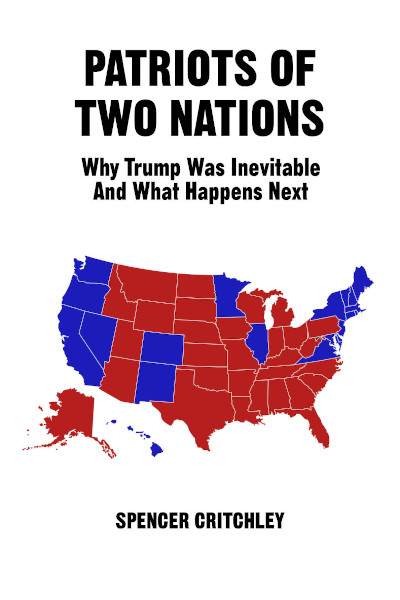
Critchley explains that on one side are the followers of Enlightenment, who believe in science, reason, and the rule of law. It was enlightenment thinkers who framed our government and wrote our Constitution. Today’s followers of the enlightenment believe in a “civic nation,” founded on a social contract between the individual and the state. The citizen exchanges a measure of personal liberty for membership in a mutually supportive society.
On the other side are followers of the Counter-Enlightenment, who believe a focus on reason is too constraining. It doesn’t account for culture, art, tradition, spirituality — the elements that bring richness to life. This group believes in an “ethnic nation,” which is rooted in their race and culture. While this focus can appeal to bigots, counter-enlightenment people are not necessarily racist. In an interview with the Post, he said,“Many thoughtful people come from the counter-enlightenment world view.”
The gap between the two world views is so great that Critchley, a former campaign advisor to Barack Obama, says that it has created alienation and suspicion, helped on by politicians and the media playing on resentments. “Much of the division has been exaggerated,” he says. “A lot of money can be made by making people angry and afraid.”
Yet there are a considerable number of Americans who have embraced the extremes of ideology. At the far extremes of counter-enlightenment are white supremacists. At the other extreme are people who Critchley says believe in “identity policing, endless litigating, political correctness, and punishing people for not being ‘woke’ enough.”
Critchley, who considers himself part of the enlightenment crowd, is aware of how easy it is to dismiss the opposing points of view. He says, “We live lives of high rationalism most of the time. We think in terms of facts, logic, productivity. We tend to believe facts and logic explain everything.”
The two groups’ attitudes toward culture is significant, he adds. “Enlightenment people can become disconnected from any particular culture. This is part of what’s behind the ‘globalist’ charge. Sometimes that refers to the global financial elite, and sometimes it’s veiled antisemitism, but it can also point to this sense of cultural emptiness.” Critchley says that globalism is a concept that disconnects people from the symbols and traditions that shape their lives. Critchley compares it to the campaign to teach Esperanto, “the international language.” He wonders at “the idea that anyone would want to speak a language rooted in no culture at all.”
What is true in language is also true of history, art, and human psychology. Counter-Enlightenment people “would argue that people are inherently subjective and tied to a particular location.” Culture is crucial.
Says Critchley, “The Democratic party — I’ve seen it up close — is sometimes stuck in a science-driven world. They’re really good at using science and coming up with solutions.” But they can be oblivious to culture.
“A lot of liberals would be surprised that while more than 90 percent of Blacks consider themselves Democrats, only about a quarter would define themselves as liberal.” Critchley says that they need to recognize “there are many cultures alive in the Black community.”
The current level of social friction threatens to get out of hand. But the situation can’t be blamed on a polarizing president and the general tone of today’s politics, Critchley maintains. The ideological division is far older and runs far deeper, and will still be with us after this administration has gone.
Sooner or later, we must make the effort to reunite. The solution, Critchley says, is like dieting: “it’s simple but it’s hard.”
When talking with someone with a different perspective, he advises, “stop trying to make sense for a while, stop trying to correct them. Practice some awareness, compassion. And find some shared values.”
It will probably take some digging and the results may be surprising. “We must learn to respond to people in a more intuitive way,” Critchley says. “We must build trust. Connect first, debate later.”
Featured image: Map from the cover of Patriots of Two Nations: Why Trump Was Inevitable and What Happens Next by Spencer Critchley (McDavid Media, ©Spencer Critchley. All rights reserved.)
The Best Road Trips in Every State
We scoured the nation for the best driving excursions in every state. Many showcase stunning fall foliage backdrops. Others present unique and spectacular geography. In some cases, we bypassed the best-known byways to feature hidden gems. Oh, we surely missed some — there are just too many to choose from. (Let us know your favorites in the comments below..) We hope to inspire you to venture out and explore this beautiful country we call America. Happy motoring!
Alabama
Wrapping around Mobile Bay on Alabama’s southern tip, the 130-mile Coastal Connection Scenic Byway runs alongside pristine, powder-white Gulf beaches, shorebird sanctuaries, pecan and produce farms, and historic Fort Gaines and Fort Morgan.
Alaska
Dream of driving from Fairbanks to the Arctic Circle? Then gas up and prepare to not see another human soul for hours, just lots of wildlife, including migrating caribou, Dall sheep, musk oxen, and arctic foxes. While spellbinding, the rugged 415-mile mountain-pass Dalton Highway is largely void of civilization and creature comforts.
Arizona
A favorite of motorcyclists and sports car enthusiasts, the harrowing 123-mile Coronado Trail, aka Devil’s Highway, ascends, narrows, dips, and twists through more than 400 switchbacks as it climbs from high desert floor to 9,000-foot alpine forest.
Arkansas

Arkansas’s 363-mile section of the multi-state Great River Road runs alongside the Mississippi River through its Delta region, brimming with ancient Native American and Civil War sites, steamboats, and Mark Twain’s boyhood haunts.
California
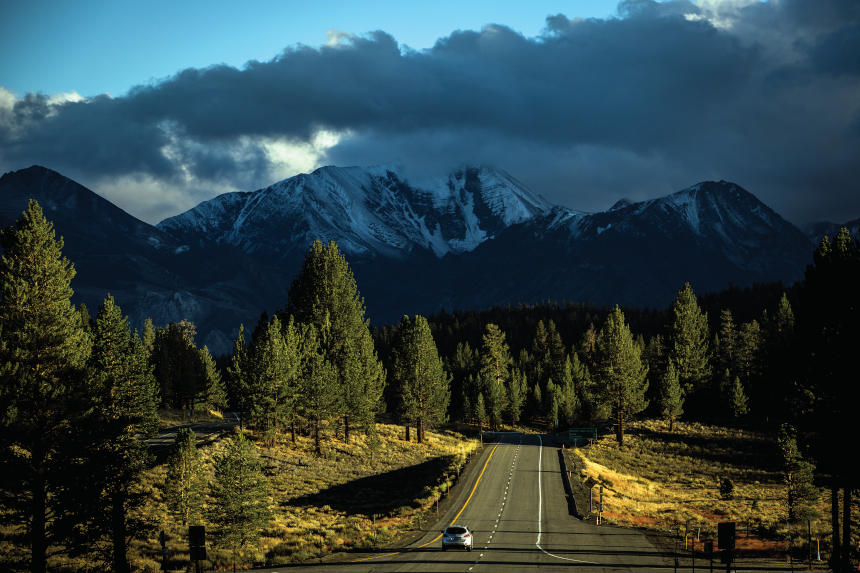
U.S. Route 395, “El Camino Sierra,” stretches from Mexico to Canada, and the California section packs in some of its most diverse landscapes: 14,000-foot peaks, tufa formations, ancient volcanos, ghost towns, and a bristlecone pine forest.
Also check out: The Gold Rush Highway journeys through California’s gold rush era in the foothills of the Sierra Nevadas.
Colorado
Drivers cross the Continental Divide twice while traversing the Top of the Rockies Scenic Byway’s 82 miles from Aspen to Copper Mountain. The road seldom drops below 9,000 feet while passing through three national forests — Pike, Arapaho, and White River — abounding with bighorn sheep, red-tail fox, and mountain goats.
Connecticut
Rolling hills, covered bridges, historic taverns, charming villages … the vast array of Litchfield Hills Loop’s scenic routes will have you wondering if you’ve been dropped in an Andrew Wyeth canvas.
Also check out: Trailing the coastline, the 105-mile Connecticut Coast Scenic Highway between Stonington and Greenwich features salt marshes, wide beaches, and some of the East Coast’s oldest towns.
Delaware

Tranquil, two-lane Bayshore Byway parallels the Delaware Bay and migratory flyways between New Castle and Lewes. Antique-filled towns give way to corn and soybean farms, wildlife refuges, and marshlands.
Florida
The southernmost leg of Route 1 spans 165 miles over scenic bridges from Miami to Key West, showcasing coral islets, reedy wetlands, and unobstructed sunsets over the aquamarine sea. Watch for white herons, roseate spoonbills, pelicans, and dolphins.
Georgia
Three-state Russell Brasstown Scenic Byway travels 40 miles through Georgia’s mountain country, crisscrossing Brasstown Bald (Georgia’s highest peak), granite canyons, and the Chattahoochee River.
Hawaii
Just 11.2 miles long, the Big Island’s Mauna Loa Road traverses lava fields and koa forests while climbing majestic Mauna Loa for panoramic views of Kilauea volcano.
Also check out: Famed for its 620 curves and 59 bridges, Maui’s Hana Highway abounds with fragrant South Pacific foliage (think rainforests, cascading waterfalls, and multi-hued beaches).
Idaho
The Ponderosa Pine Scenic Byway’s 131 wooded miles wend from Boise to Sun Valley, past old gold mines, Western towns, and national forests, including the massive Frank Church–River of No Return Wilderness.
Illinois
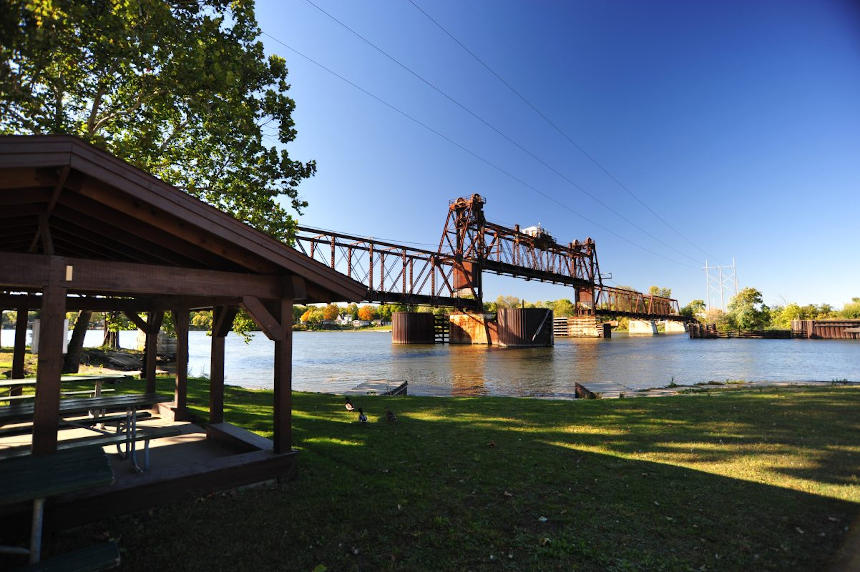
Nicknamed a “living museum,” 150-mile Illinois River Road Scenic Byway embodies more than 100 nature-based, historic, and cultural sights, including Lewistown’s Dickson Mounds Museum, which interprets the ecology of the Illinois River.
Indiana
The Indiana track of America’s first paved transcontinental route, the Lincoln Highway, includes a sundry of historic sites (some commemorating Abraham Lincoln) a circa-1889 synagogue, and lodgings from the early days of road-tripping.
Iowa

Travel the 82-mile Covered Bridges Scenic Byway across Madison County and see the five famous bridges. Also drive by the birthplace and museum of legendary actor John Wayne and the stunning Iowa Quilt Museum, both in Winterset.
Kansas
Western Vistas Historic Byway, a 102-mile, one-time pioneer and cowboy trail (trod by the likes of “Wild Bill” Hickok), encompasses extraordinary landscapes, 70-foot spire Niobrara Chalk formations, dinosaur fossils, and limestone-ledged buttes amid roaming buffalo and prairie dogs.
Kentucky
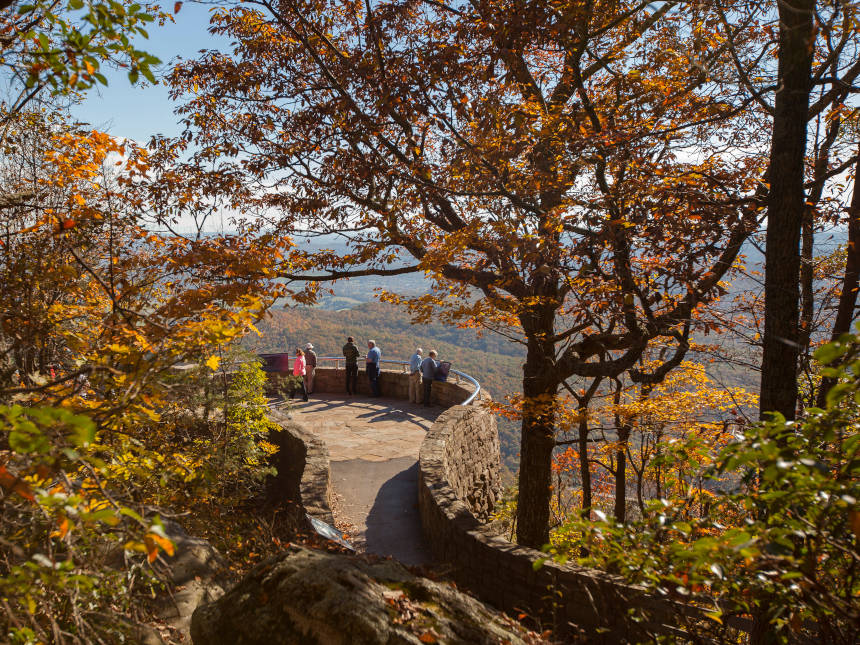
Trekked by Daniel Boone, Civil War soldiers, and European explorers, the 92-mile Wilderness Road Heritage Highway features Cumberland Gap National Park, mountain music venue Renfro Valley, and Kentucky’s crafts capital, Berea.
Louisiana
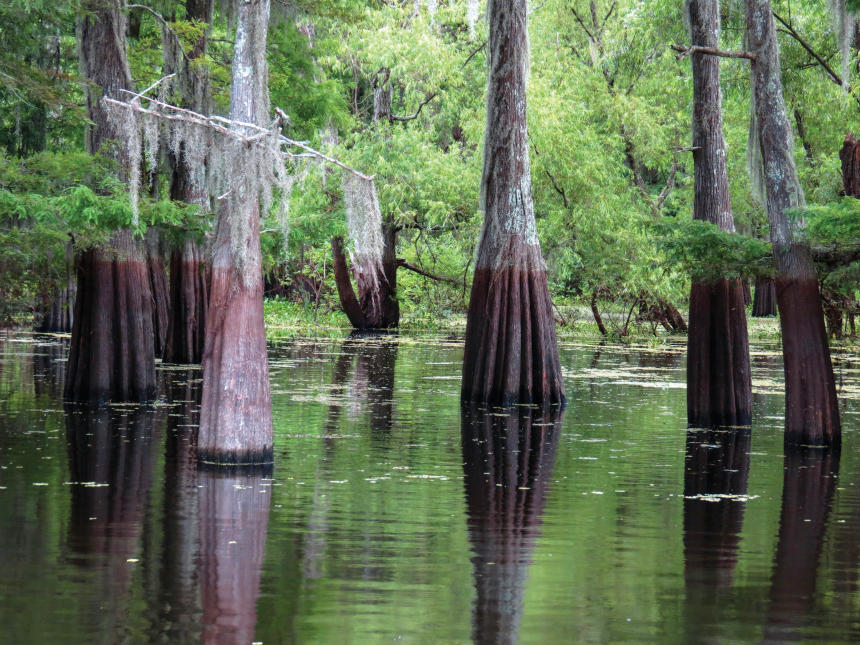
Bayou Teche Byway loops 125 miles through lush bayous, Acadian cultural districts, and the country’s largest wetland, the million-acre Atchafalaya Swamp Basin.
Maine

The 125-mile Bold Coast Scenic Byway winds through Downeast Maine’s craggy seashore, foggy coastal forests, blueberry barrens, and historic towns Milbridge and Eastport, filled with maritime heritage.
Also check out: Old Canada Road National Scenic Byway, a mountain-hugging trail tracing a logging-era U.S.–Quebec trade route.
Maryland
Three hundred years of history, marked in significant mileposts, tollhouses, taverns, and stone arch bridges, line the Historic National Road’s 170 miles spanning Baltimore to Maryland’s western border.
Massachusetts
Mohawk Scenic Byway began as a Native American trade route. Centuries later, Benedict Arnold marched his army here. Today, its 69 miles offer centuries-old churches, mountain passes, pristine rivers, and quaint towns.
Michigan

U.S. Route 23 stretches from Florida to northern Michigan. Avoid all of it … except its final 200 miles along Lake Huron’s Sunrise Coast. The panoramic Huron Shores Heritage Route snakes along hardwood forests, waterfalls, sand dunes, and freshwater beaches.
Minnesota
Road trippers pass by four of Eastern Minnesota’s state parks, basalt rock cliffs, steep gorges, and 19th-century towns, including lovely Stillwater, following the 124 rolling miles of the St. Croix Scenic Byway.
Also check out: Minnesota River Valley National Scenic Byway, 287 miles of prairies, woodlands, and Dakota heritage.
Mississippi

Traversing three states, the Natchez Trace was once an east-west passage for Native Americans, slave traders, and campaigning presidents. Mississippi’s 308 miles include a Plaquemine-culture ceremonial site, the antebellum Windsor Ruins, and Elvis’s birthplace.
Missouri
Just 27 miles long, Glade Top Trail in the Ozarks is the Show Me State’s only National Forest Scenic Byway. Largely unchanged since its construction by the Civilian Conservation Corps in the 1930s, its many panoramic “pull-outs” showcase limestone glades, tall-grass prairies, and eastern red cedars in the Mark Twain National Forest.
Montana
The All-American Scenic Byway Beartooth Highway abuts a plethora of national forests, climbs high alpine plateaus, overlooks glacial lakes, and crosses the 45th parallel — the halfway point between the North Pole and Equator.
Also check out: Seeley-Swan Scenic Drive spans 90 miles between the Bob Marshall Wilderness and Mission Mountains.
Nebraska
Outlaw Trail Scenic Byway’s 231 miles of rough, rambling topography made it a prime hideout for Old West bandits like the James Gang and Doc Middleton. Sights include Smith Falls (Nebraska’s tallest), Monowi (a one-resident town), and authentic cowboy saloons.
Nevada
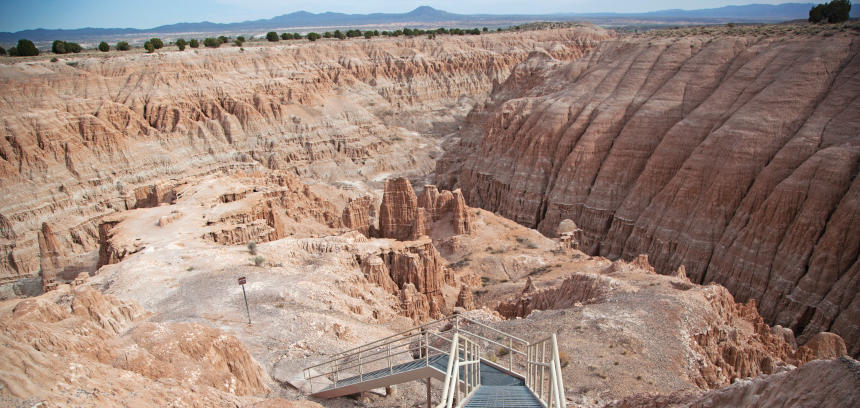
The landscape fluctuates between high and low desert microclimates along 355-mile Great Basin Highway. Don’t miss the Miller Point and Mathers Overlooks, Lehman Caves, and the 19th-century Ward Charcoal Ovens.
New Hampshire
The Kancamagus Scenic Byway’s 34.5 alpine miles through the White Mountains deliver monumental panoramic overlooks (especially the 2,860-foot Kancamagus Pass), dramatic bluffs, lush forests, and Sabbaday Falls.
New Jersey
Bucolic 89-mile CR-519 feels more New England than central Jersey. This country lane twists through picturesque woodlands with idyllic rivers, wholesome farmsteads, and tiny towns. Fittingly, it’s nicknamed The Land of Make Believe Highway, after one of its many roadside attractions.
New York
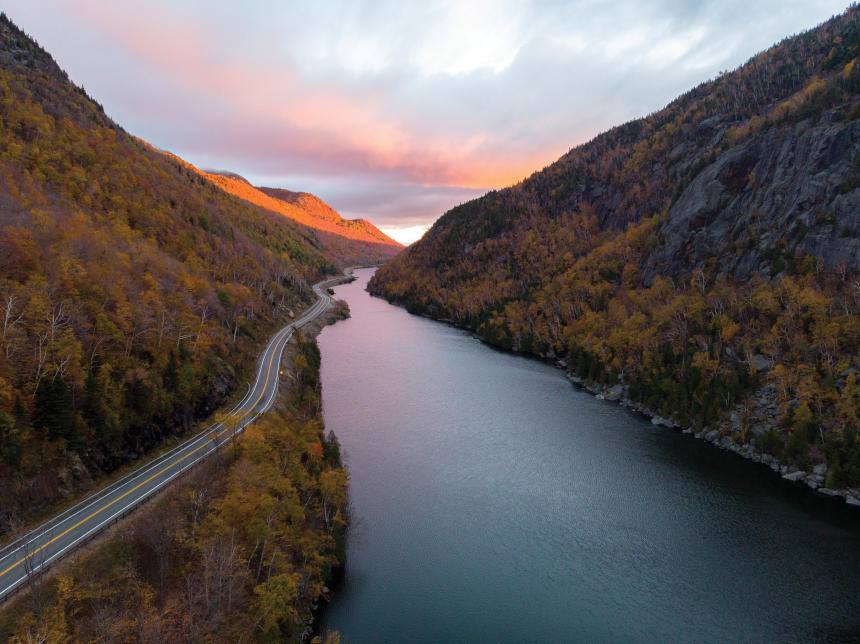
We’ll bet no other 30-mile drive ever felt as thrilling. Interconnected by a series of stunning mountain passes, the Adirondacks’ High Peaks Scenic Byway ascends through verdant forests and past crystal-clear waterways, offering views of more than 40 peaks that soar over 4,000 feet.
New Mexico
Trail of the Mountain Spirits Scenic Byway weaves for around 100 miles through high desert forests and wilderness regions where Wild West explorers once roamed. Interspersed within jaw-dropping vistas are the Gila Cliff Dwellings National Monument, desert towns, and the Continental Divide.
North Carolina
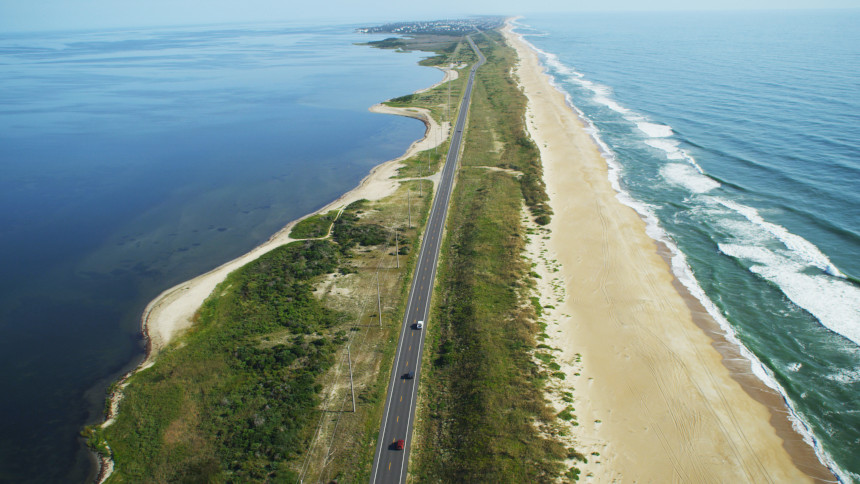
Sandwiched between the Atlantic Ocean and Pamlico Sound, Outer Banks National Scenic Byway breezes through 138 miles of driving (plus another 25 miles by ferry) alongside salt-air beaches, sea turtles splashing around barrier islands, quiet coastal villages, and wildlife refuges.
Also check out: Famous Blue Ridge Parkway, America’s longest linear park, runs 469 miles through the breathtaking Blue Ridge Mountains of North Carolina and Virginia.
North Dakota
Extending 64 miles from the Killdeer Mountains to the Badlands, Killdeer Mountain Four Bears Scenic Byway’s hilly landscape provides visual respite from North Dakota’s flat, barren terrain. The drive is a cultural tour of the region’s history, featuring the 1864 Killdeer Mountain Battlefield and the reservations of native Mandan, Hidatsa, and Arikara tribes.
Ohio
The 26.4-mile Hocking Hills Scenic Byway offers so many Instagram-worthy vistas and must-see historic sites, driving it could take the whole day. The road winds around Hocking Hills State Park’s towering Black Hand sandstone cliffs, carved gorges, recessed caves, and plunging waterfalls.
Oklahoma
Nineteenth-century Texas ranchers drove millions of cattle across the Chisholm Trail to Kansas for beef distribution in the north. The Oklahoma portion (now US-81) is exquisitely rural, with sightsee stops dedicated to cowboy and outlaw history.
Oregon
The Pacific Coast Scenic Byway follows Oregon’s 363-mile coastline. Public beach access is protected by state law, ensuring opportunities for up-close views of soaring cliffs, marine caves, dunes, splashing sea lions, and naturally formed landmarks.
Also check out: Circling from Baker City to Le Grande, Hells Canyon Scenic Byway snakes above America’s deepest (7,993 feet) canyon.
Pennsylvania
The 265-mile Scranton-to-Warren portion of Scenic Route 6 is at its most impressive in the Endless Mountains, Pennsylvania Wilds (home to Pennsylvania’s Grand Canyon), and the hardwoods and hemlock of the Allegheny National Forest.
Rhode Island
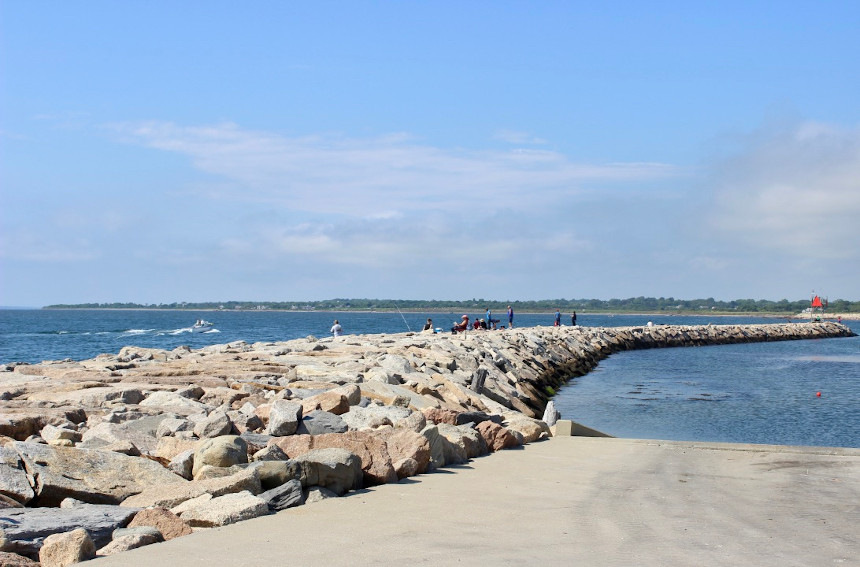
Covering just 13 miles in the nation’s smallest state, RI-77 offers waterfront Sakonnet Peninsula vistas and alluring places to explore: Nonquit and Nannaquaket Ponds, the Emilie Ruecker Wildlife Refuge, and historic towns Tiverton Four Corners and Little Compton.
South Carolina
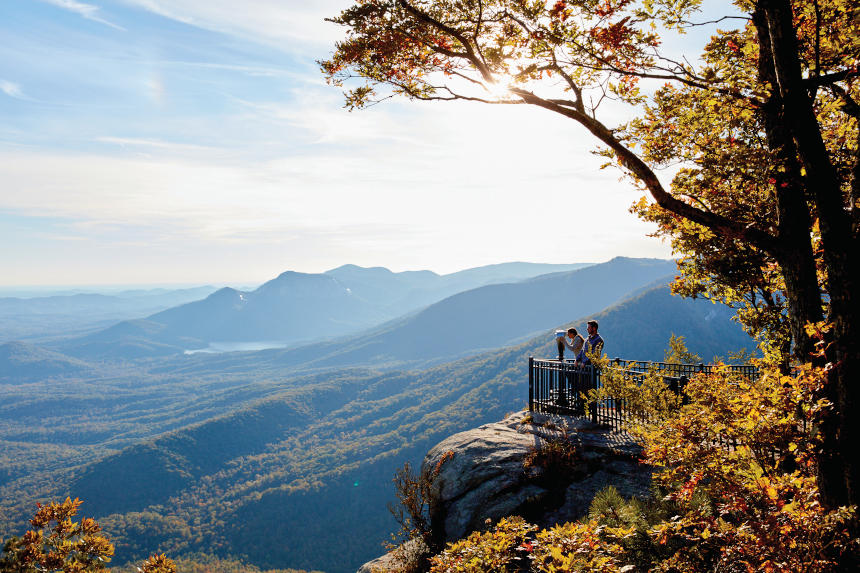
We love 118-mile Cherokee Foothills Scenic Highway’s picturesque path through the Blue Ridge Mountain’s Piedmont region, featuring glistening green forests with cascading waterfalls, jagged granite cliffs, and the postcard-perfect mountain town Walhalla.
South Dakota

The 68-mile Peter Norbeck National Scenic Byway drives like an amusement park ride, tackling hairpin curves, spiraling bridges, plunging tunnels, and granite pinnacles. Mt. Rushmore and Cathedral Spires are added bonuses.
Tennessee
The Cherohala Skyway gives you mile-high views of the Cherokee and Nantahala National Forests as it zigzags past freshwater mountain lakes and waterfalls, crimson and gold vistas, and apricot fall foliage.
Texas

The longest highway in Texas, the 542-mile, two-lane Highway 16 travels through dusty ranchlands, red rock hills, cowboy towns, and the Hill Country’s “Swiss Alps of Texas.”
Utah
Traversing the Grand Staircase-Escalante, Henry Mountains, and Capital Reef Natural Park, the otherworldly geology along 123-mile Scenic Byway 12 doesn’t disappoint with its random arches, “hoodoo” rock formations, and deep-slot canyons.
Vermont
The 51-mile Northeast Kingdom Scenic Byway showcases quintessential Vermont backcountry: hilly farm towns, colorful mountains, covered bridges, and shimmering lakes.
Also check out: The Crossroad of Vermont Byway with panoramic views of and from the Green Mountains.
Virginia
Skip Skyline Drive, swarming with bumper-to-bumper scenery seekers. Southbound from Winchester to Roanoke, the Wilderness Road meanders through the Shenandoah Valley’s historic towns and natural wonders: vertiginous sandstone cliffs, gushing waterfalls, and majestic mountains.
Washington
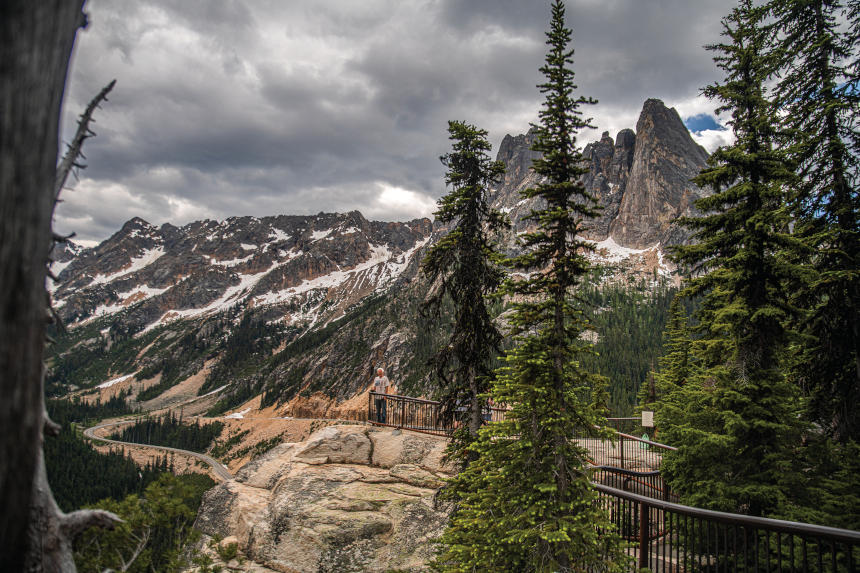
The 440-mile Cascade Loop encompasses three scenic byways, touring through Washington’s diverse array of ecosystems: Puget Sound islands, open desert, lush forest, craggy alpine peaks, sagebrush lowlands, and cityscapes.
West Virginia
The 180-mile Midland Trail National Scenic Byway offers mountain landscapes; plummeting waterfalls; purveyors of authentic Appalachian craft food, drink, and art; mountain-music venues; and adventure destinations for rafting, spelunking, and fly fishing.
Wisconsin
The 100-mile Lower Wisconsin River Road through the Driftless Area was Wisconsin’s first designated scenic byway. Following the Wisconsin River, it winds around rocky bluffs, through mysterious bottomlands, and into quaint river towns.
Wyoming
Encompassing 162 miles of steep mountain passes and verdant forests, through Grand Tetons National Park and famous Jackson Hole, Parks Centennial Scenic Byway is cited as one of the finest drives in the Rockies.
Stephanie Citron (stephaniecitron.com) is a contributing editor for The Saturday Evening Post.
This article is featured in the September/October 2020 issue of The Saturday Evening Post. Subscribe to the magazine for more art, inspiring stories, fiction, humor, and features from our archives.
Featured image: Maciej Bledowski / Shutterstock
The War That Made Us Who We Are
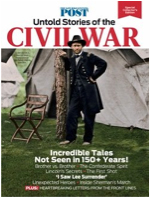
This article and other stories of the Civil War can be found in the Post’s Special Collector’s Edition, The Saturday Evening Post: Untold Stories of the Civil War.
—This account appeared in the March/April 2011 issue of The Saturday Evening Post.
The war fought by Americans against Americans on American soil, for four excruciating years is still the deadliest war in American history. More than 600,000 fighting men were killed, some of them brothers in arms against brothers, and uncounted civilians died. It was a war over nothing less than whether to preserve or end the United States of America.
Most armed conflicts are about territory. This one was about ideas. The war would put an end to slavery. It would also create, if painfully, a cohesive single republic — more united than it had ever been before. In fact, the Civil War transformed the United States from a plural noun to a singular one. Before, you would say the United States “are.” Ever since the war, we say the United States “is.”
War became inevitable in December 1860, when South Carolina declared that it would no longer be a part of the United States. Abraham Lincoln had just been elected president, and the Southern states were convinced he would immediately outlaw slavery, on which their economy depended. They resolved to leave the Union rather than have their way of life overthrown. In February 1861, South Carolina and five other states announced that they were now the Confederate States of America. U.S. Army forces had to retreat to Fort Sumter, a granite fortification in the harbor of Charleston. When the forces refused to leave Fort Sumter, state militiamen waited, wore them down by preventing supplies from getting through, and then opened artillery fire on them. The bombardment lasted for 33 hours, until 4,000 shots and shells set Fort Sumter on fire. Finally, the U.S. flag came down, and the Fort surrendered.
No one imagined how long and devastating the war would be. The first big battle was fought in July 1861, at Bull Run in Virginia, near Washington, D.C., where Union troops attacked Confederate forces in hopes of putting a quick end to the conflict. The Confederates withstood the assault and then counterattacked, and the battle turned into a rout of the Union forces. Many hundreds on both sides were killed, and thousands more were injured. Americans began to see what a long nightmare they had trapped themselves in.
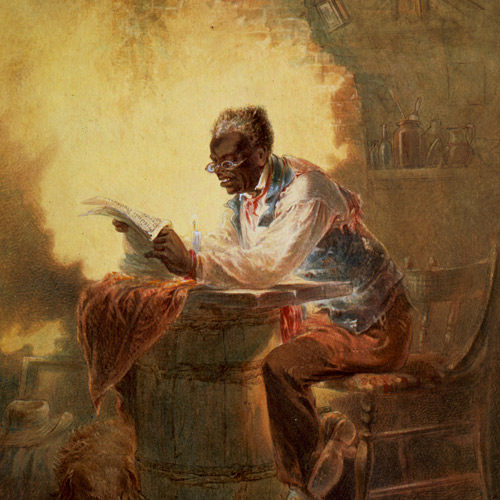
For more than a year after that, Southern troops won victory after victory under a brilliant general, Robert E. Lee, while Lincoln was disappointed by one irresolute Union general after another. One of the first big wins for the North was at The Battle of Antietam, in September 1862. The day it was fought remains the bloodiest day in American his- tory, with 23,000 casualties. Antietam turned a corner for the Union by stopping a northward advance by Lee’s army, and that victory gave Lincoln the confidence to issue the preliminary Emancipation Proclamation. On September 22, 1862, he made the sweeping, revolutionary announcement that all slaves in Confederate states would be free as of the following January 1.
Since the Proclamation applied only in states the federal government had no control over, it didn’t really free any- one except in a few Union-occupied parts of Confederate territory. But it told the world — and the captive blacks of the American South — that the war was not simply about preserving the Union. It was undeniably about slavery.
The war dragged on, with both sides more determined than ever after the Emancipation Proclamation. A turning point was reached in early July 1863, when Confeder- ate troops that had invaded the North were turned back in the epochal three-day battle in Gettysburg, Pennsylvania, while in Mississippi, Union forces took control of the city of Vicksburg, freeing the Mississippi River from the Con- federacy. As President Lincoln put it, “The father of waters again goes unvexed to the sea.” That fall he delivered his great speech at the battlefield in Gettysburg, where 170,000 soldiers had clashed and 7,500 had been killed, saying “that we here highly resolve that these dead shall not have died in vain — that this nation, under God, shall have a new birth of freedom — and that government of the people, by the people, and for the people shall not perish from the earth.”
Many thousands more were yet to die, though. Lincoln finally found the commanding general he had been looking for in Ulysses S. Grant, and Grant pursued a relentless war of attrition against Robert E. Lee’s Army of Northern Virginia, while General William T. Sherman cut a crippling swath through Georgia, devastating the heart of the deep South. The war dragged on until April 1865, when Robert E. Lee surrendered to Grant at Appomattox Court House, Virginia. Just a week later, President Lincoln was assassinated by an enraged Confederate sympathizer, John Wilkes Booth.
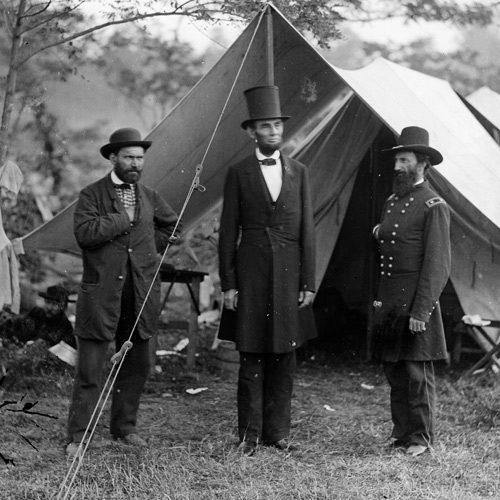
The wounds left by the war did not quickly or easily heal. Reconstruction, a bitterly opposed attempt by the North to remake the South, lasted until 1877 and ultimately failed.
The Civil War brought an end to slavery and reunited the nation, but the pain of reconciling the differences, many of which began with the birth of the republic, lingers still. The war made our motto true E pluribus unum — from many, one — but the work of making us one is never complete.
8 Things You Didn’t Know About the Marines
The phrase “The United States Marine Corps” immediately conjures a number of images and ideas. Toughness. Honor. Tradition. And while that reputation can be traced back to 1775, the “Act for establishing and organizing a Marine Corps” was signed by President John Adams on this date, July 11, in 1798. On its 220th anniversary, we look some of the longstanding traditions that make the Marines the Marines. Some are reflected in the modern culture of this military branch, while others are just downright peculiar.
1. The Marines Have Two Birthdays
The modern Marine Corps descended from the Continental Marines assembled under the Continental Marine Act of 1775, which was initiated by the 2nd Continental Congress on November 10th of that year. Though the Continental Marines were disbanded at the end of the Revolution, the United States Marine Corps still commemorates November 10th as their official creation.
The Marines were “reborn” in 1798. The creation of the United States Navy and Marine Corps grew out of clashes with the French navy during the French Revolutionary Wars. An act of Congress formed the Navy in 1794, with Marines recruited to serve on newly created ships by 1797. Adams signed the “Act for establishing and organizing a Marine Corps,” authorizing a battalion of 500 privates along with a major and other officers. Revolutionary War veteran William Ward Burrows was made an initial major. Marines would serve in the Quasi-War, that undeclared war between the new French Republic and young United States that occurred between 1798 and 1800.
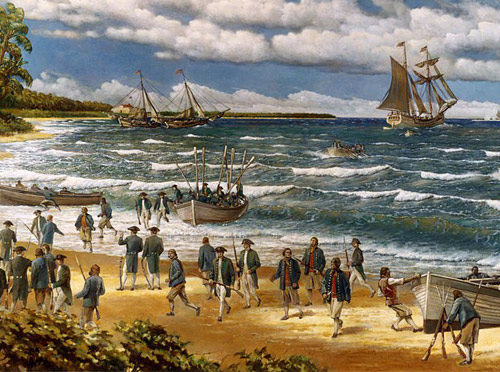
2. Why the Marines are “Marines”
The term Marine came from the type of infantry that supports naval operations. The Marines of the American Revolution typically mounted amphibious assaults, landing from tall ships to conduct raids in locations like British ports in the Bahamas. During the Barbary Wars against piracy that ran from 1800 to 1815, Marines frequently fought in ship-to-ship battles, boarding vessels to capture them.
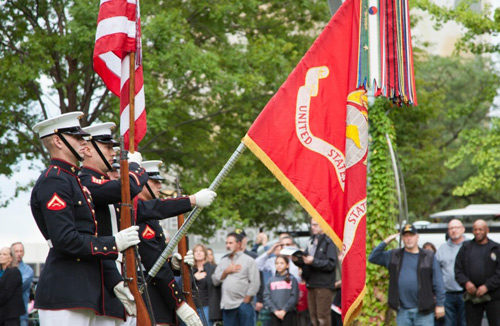
3. Thomas Jefferson Chose the D.C. Barracks Site
In 1801, President Thomas Jefferson and Burrows, now Lieutenant Colonel Commandant of the Marine Corps, chose the site of the Marine Barracks in Washington, D.C. A National Historic Landmark, it is still in use today as the official residence of the Commandant, the home of the U.S. Marine Drum and Bugle Corps, and the main ceremonial location for the Corps.
4. The Dress Blues Were Overstock
Sometimes a uniform is carefully designed and thought out over time. And sometimes, you take what you can get. The familiar ceremonial “dress blues” of the Corps adopted their look from an overstock of blue jackets with red trim that Burrows received upon his original appointment to major.
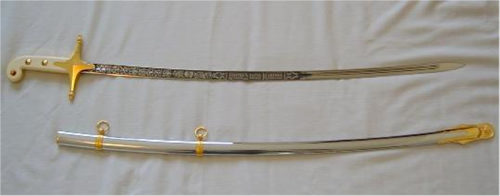
5. The First Marine Sword Was a Gift
While battling Barbary pirates in Africa, First Lieutenant Presley O’Bannon, eight other Marines, and over 300 mercenaries of Arab and European origin mounted an assault on Tripoli in an attempt to liberate the captured crew of the U.S.S. Philadelphia. Though they did not take the city, deposed Prince Hamet Karamanli allegedly presented a Mameluke sword to O’Bannon after the Battle of Derna. The sword story sparked the tradition of Marine officers wearing swords in dress blues.
6. Why Tripoli Is in the Marine Hymn
The other lasting legacy of the action was the inclusion of the lyrics “to the shores of Tripoli” in the Marines’ Hymn by Thomas Holcomb in 1942. The Hymn is the oldest of any of the songs that represent the U.S. Armed Forces. The original music was written in 1867 by Jacques Offenbach, but it wasn’t adopted as the official music of the Corps until 1929.
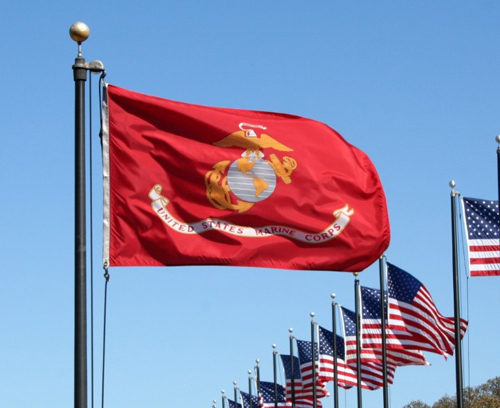
7. There Are a Lot of Active Marines
Today, the USMC boasts 186,000 active Marines with around 38,500 reserves. Roughly 7.6% of today’s Marines are women. Of the more than 22 million veterans living in the United States as of 2014, less than 1% were Marines.
8. They Perform MANY Jobs
Over 336 MOS (military operational specialist) codes, or job types, are presently available in the Marines; paths include everything from infantry to avionics to 60 different categories of linguistics. Even as new avenues for duty continue to expand, it’s safe to say that, even after more than 200 years, the Marines continue to pursue high standards in their service to the country.
8 Other Things That Happened on the Fourth of July, and One That Didn’t
Independence Day is such an institution in the United States that when we hear “Fourth of July,” many of us think of it first as the name of a holiday and not simply — as it is in so many other countries — a calendar date. Considered the birthday of America, the holiday commemorates the adoption of the Declaration of Independence in 1776, but in the more than two centuries since, it isn’t the only notable event to have happened on that date.
Here are eight other things that happened on that day, plus one thing that surprisingly didn’t happen on the Fourth of July.
1. 1802: The Military Academy at West Point Opens for Instruction
What began as fortifications at the mouth of the Hudson River in 1778 is now the oldest continuously occupied military post in the U.S. In 1802, President Thomas Jefferson signed the Military Peace Establishment Act into law, which in part established a new U.S. Military Academy at West Point whose primary purpose at the time was to train expert engineers. On July 4 of that year, the new academy formally opened for instruction.
Ulysses S. Grant and Robert E. Lee were both West Point graduates, as was Confederate President Jefferson Davis. West Point grads played a big role in the U.S. military during World War II: General George Patton, General Douglas MacArthur, and General (later President) Dwight D. Eisenhower were all alumni.
West Point grads have distinguished themselves outside the military, too. Other successful alumni include astronaut Edwin “Buzz” Aldrin, Pittsburgh Steelers left tackle Alejandro Villanueva, and Duke University head basketball coach Mike Krzyzewski.
2. 1817: Construction Begins on the Erie Canal
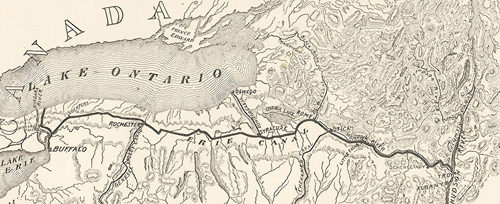
It took eight years for engineers and laborers to create the 4-foot-deep, 40-foot wide, 363-mile-long canal that would connect Albany and the Hudson River to Buffalo and Lake Erie. But it was worth it: This massive public works project opened up travel to the west and was a key influence in turning New York City into America’s principal seaport and a center of business and finance.
In 2000, the U.S. National Parks Service designated the Erie Canalway National Heritage Corridor.
3. 1826: Thomas Jefferson Dies
It seems a poetic justice that the man most responsible for writing the Declaration of Independence should die on the 50th anniversary of its adoption. Though his exact cause of death at age 83 is unknown, his health had been in steady decline since 1818.
4. 1826: John Adams Dies
The second and third presidents of the United States died within five hours of each other. Though they fought side by side to create a free America, after they had achieved that goal, they discovered they had very different ideas about what these new United States should look like. They became bitter political rivals for decades, only rekindling their friendship later in life.
It’s a part of American legend that the 90-year-old John Adams’ last words were “Jefferson still survives,” not knowing that the younger man had passed earlier that day, but the veracity of this legend is questionable.
5. 1845: Henry David Thoreau Moves to Walden Pond
The American transcendentalist began his two-year experiment in simple living on the Fourth of July. On that date, he moved into a small cabin he had built himself on the shores of Walden Pond, near Concord, Massachusetts, on land owned by fellow philosopher Ralph Waldo Emerson. In 1854, he published his record of the experience in Walden, or Life in the Woods to moderate success.
6. 1855: Leaves of Grass published
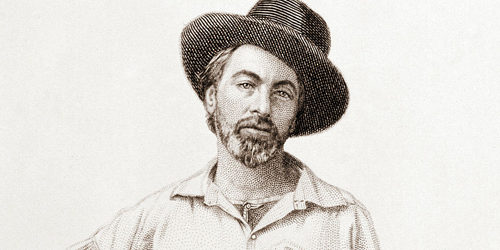
Though the 795 copies of the first edition of Leaves of Grass — which Walt Whitman designed and published himself — included only 12 poems over 95 pages, it changed the course of poetry in America for good. Whitman added, revised, and republished his poems throughout his life so that, by the time he died and after several editions, Leaves of Grass contained 389 poems.
7. 1939: Lou Gehrig’s “Luckiest Man” Speech
On May 2, 1939, New York Yankees first baseman Lou Gehrig ended his record-setting streak of 2,130 consecutive games by benching himself for poor play. He would never play again. A month and a half later, he was diagnosed with amyotrophic lateral sclerosis.
On July 4, the Yankees held Lou Gehrig Appreciation Day in a sold-out Yankee Stadium. Gehrig, who was petrified of crowds, wasn’t originally expected to speak, but such an outpouring of love pushed him to it. That afternoon, he stepped up to the mic and delivered his “Luckiest Man” speech, which is still considered one of the most moving speeches ever given at a sporting event. In it, he acknowledged not only the fans and the other players, but even the groundskeepers and his own mother-in-law.
8. 1997: Pathfinder Lands on Mars
After a six-month journey, the first Mars Pathfinder landed on the Red Planet on July 4, 1997. It became the base station for the free-range robotic rover Sojourner — Earth’s first (successful) interplanetary rover. NASA received its first picture of Mars at about 9 p.m. that day.
Pathfinder and Sojourner collected 2.3 billion bits of data during their lifespan and sparked two decades of Mars exploration. Though the mission was only supposed to last up to 30 days, NASA continued to receive data for 83 days.
Not on the Fourth of July: The American Colonies Declare Independence from Great Britain
The members of the Second Continental Congress voted 12-0 with one abstention (New York) on a motion to officially separate the American colonies from British rule on July 2, 1776. By July 3, two Philadelphia newspapers, the Pennsylvania Evening Post and the Pennsylvania Gazette, were already reporting that “the Continental Congress declared the United States Colonies free and independent States.” That same day, John Adams wrote home to his wife, Abigail: “The Second Day of July 1776, will be the most memorable Epocha, in the History of America.” Adams believed the Second of July, not the Fourth, would become a national holiday.
What we celebrate now as Independence Day marks the day in 1776 when the final edited version of the Declaration of Independence was adopted by the Continental Congress, though the final signatures on it wouldn’t be collected until early August.
50 Years Ago: Taking On the Weapons Industry
Nuclear physicist Ralph Lapp helped to develop the atomic bomb before petitioning against its use in 1945. Lapp toured the country in the 1950s and ’60s lecturing about nuclear radiation and civil defense, but in 1968 he penned the Post editorial “The Weapons Industry Is a Menace,” taking acute aim at the so-called military-industrial complex. Lapp decries the burgeoning “defense socialism” in the U.S., claiming Eisenhower’s famous 1961 warning had come to bear in a nation whose welfare was “permanently tied to the continued growth of military technology and the continued stockpiling of military hardware.” Lapp’s rebuke of defense spending during the Cold War highlights the problems with weapons excess that are still debated 50 years later.
“The Weapons Industry Is a Menace” by Ralph E. Lapp (June 15, 1968)
The United States is becoming a weapons culture. The health of our entire economy has come to depend on the making of arms. The machinery of defense, lubricated by politics and technology, has become a juggernaut in our society. Pressures exerted by the giant corporations that compose our military-industrial apparatus are felt in the Pentagon, in the White House and in Congress. Congressmen are re-elected depending on their success in winning defense contracts for their constituencies; government funds support vast military research projects on campuses across the country; the scientific community has been largely corrupted or silenced by military domination.
President Eisenhower warned of this ominous trend in his farewell address back in 1961: “In the councils of Government we must guard against the acquisition of unwarranted influence, whether sought or unsought, by the military-industrial complex. The potential for the disastrous rise of misplaced power exists and will persist.”
That warning has become the present reality. Since the end of World War II, and especially since Korea, the manufacture of arms has ceased to be an emergency measure whereby private firms do their bit for Uncle Sam. Instead. many U.S. corporations have become primarily arms makers. Their business and their profits depend on winning more and bigger contracts from the Department of Defense. Some companies, like North American Rockwell, General Dynamics and McDonnell Douglas, exist almost entirely on government arms contracts. Without this money many of them would go bankrupt. and places like Southern California or the state of Washington would become economic disaster areas.
Consider, for example, a single company — Lockheed Aircraft. In the past seven years this California-based concern has won a total of $10.6 billion in defense contracts. Uncle Sam provides 86 cents of every dollar of its corporate sales. Lockheed is not just an isolated example. During these same seven years 38 companies each have done more than one billion dollars of business with the Pentagon.
No nation can devote so much of its ingenuity, manpower and resources to the works of war without being deeply changed in the process. Our commitment to weapons making has distorted the free enterprise system of our economy into a kind of “defense socialism.” a system in which the welfare of the country is permanently tied to the continued growth of military technology and the continued stockpiling of military hardware.
This massive “peacetime” commitment to arms is new to the American experience. When one looks back and surveys the postwar years. one startling fact emerges: During these years the United States has devoted one trillion dollars to its national security! And half of this vast expenditure occurred during the Kennedy-Johnson Administrations.
These billions of dollars have meant jobs for many Americans — for electronics specialists in Boston’s Route 128 necklace of defense plants; for rocket men in factories spread out over Utah’s broad valleys; for aircraft workers in Southern California. Texas. Georgia, Washington. Kansas and Missouri.
President Eisenhower omitted any reference to political influence in his indicting phrase, “the military-industrial complex.” but it is the crux of the matter. Powerful members of Congress champion defense systems out of self-interest. Georgia’s defense bounty may be traced, for example, to the power of its Senator Richard B. Russell. who is chairman of the potent Armed Services Committee. Our senators and representatives approve the appropriations that control the fate of many a defense plant. It takes a brave legislator to vote against funds that mean jobs for some of his constituents. He becomes vulnerable not just to the unemployed defense worker but to campaign charges that he failed to support the national security program.
The power of the military-industrial complex has been greatly aided by advanced technology. Science has become the key to modern arms. Today’s weapons systems, especially those involved in hurling nuclear warheads at intercontinental range, are incredibly complex. Nuclear research has fashioned compact packages carrying the explosive power of a million tons of TNT. Chemical and electronic ingenuity have combined to perfect rockets like Minuteman and Poseidon that can carry from 3 to 10 warheads, each dispatched to a separate target. More and more our great national decisions involve complex technology and secret data about weapons.
Consider, for example, the recent decision to build a thin Sentinel system to defend against ICBM’s fired by Red China. This $5 billion project may escalate to $40 billion. Yet the public had precious little to say in this momentous decision. In a sense, even a democracy as modern as ours is dictated to by technology. When a weapons system becomes “ripe,” then it dominates its makers. In the case of ballistic-missile defense, the United States spent $4 billion in research and development, so before the decision to deploy it was made, powerful forces urged its production. Robert S. McNamara, who recently resigned as head of the Pentagon, put it bluntly: “There is a kind of mad momentum intrinsic to the development of all new nuclear weaponry. If a weapons system works — and works well — there is strong pressure from many directions to procure and deploy it out of all proportion to the prudent level required.”
One way to pressure the American people into supporting larger defense outlays is to sound the alarm about Soviet strength. Thus in the 1950s it was alleged that there was a “bomber gap,” and public support was whipped up for mass production of B-47s and B-52s.
Even before the bomber gap vanished into thin air, a “missile gap” was born. John F. Kennedy hammered away at the missile-gap issue in his 1960 campaign, decrying Eisenhower’s years in office as “years the locusts have eaten.” Yet when Kennedy became President and had time to study the available information about Soviet missiles, he discovered that the missile gap was in our favor. Nonetheless, Kennedy pressed Congress for authorization of more Minuteman and Polaris missiles.
Now a new gap is in the making — a “megaton gap.” A megaton means a million tons of TNT, or 75 times more power than the A-bomb that eviscerated Hiroshima. At some time in the future the Soviet Union may be able to hurl more megatons at the United States than we can fire back in return. This does not and cannot alter the fact that a small fraction of the present United States nuclear firepower can knock the Soviet Union out of the 20th century. Having excess kill power — overkill — is not militarily meaningful.
The heart of our strategic policy is our capability to inflict unacceptable losses on the enemy’s homeland. It’s damage, not megatons, that counts. I have calculated that as few as 45 ballistic missiles can strike at 60 million Russians living in 200 Soviet cities. No, my arithmetic is not nutty — each missile can be armed with from 3 to 10 nuclear warheads targeted on individual cities. The total megatonnage in this hypothetical attack amounts to only 21 megatons — roughly one thousandth of that once carried by our SAC bombers. But 21 megatons is the equivalent of 21 million tons of TNT, or 620 times the explosiveness of the combined power of the Hiroshima and Nagasaki bombs.
If my figure of 45 missiles seems too low, then let’s triple it. That figure would amount to less than a tenth of the actual number of missiles in our strategic strike force. Adding more ICBM’s to the U.S. arsenal, or magnifying the megatonnage, does not really alter the nuclear balance of power.
But the very concept of “enoughness” in military power is a punishing blow to the solar plexus of the military-industrial-political complex. Defense affluence is based on open-endedness on there never being enough of anything, even megatons. The United States has already stockpiled over 50,000 nuclear weapons and has a capacity to double this number rather quickly.
The man in the street is not supposed to question matters of national security. But whose judgment is he to trust? The politicians are themselves deeply implicated in the military-industrial complex; the generals traditionally don’t know what the word “enough” means, and industrialists covet contracts.
There is sound reason for gloomy forecasts about defense socialism. The United States cannot afford to lay down its nuclear arms until it is safe to do so — and that day is far from dawning. Force of arms still rules, and the United States has no choice but to maintain its armed vigilance. Moreover, it cannot become complacent about its power to deter war by depending on the status quo. For this reason, military research and development should never cease.
But the need for weapons improvement should not be viewed as a carte blanche for defense industry. Rational determination of force levels is of paramount importance to the nation’s security. Excessive weapons deployment may not only be wasteful, it may provoke competitors to unplanned arms increases, and thus escalate the arms race with no real gain in our national security. But “how much is enough” is the perplexing question that this country has avoided facing squarely.
I admit that precise definition of “enoughness” is impossible. No single person or computer can be relied on to spell out how much is enough. There must always be an insurance factor — a margin for error, but not for irrational excess. Even if by some magical process we could find a neat answer to how much military power is enough, we lack the mechanism in our democracy for a techno-military consensus. Our democracy depends on a system of checks and balances, but such restraints are lacking for the military industrial complex. Our Congress is ever ready to vote for larger defense appropriations; not once since Hiroshima has the Congress failed to fund a weapons system. It has even pushed some that the Defense Department did not want. Under congressional insistence the U.S. spent about $1.5 billion on a nuclear-powered airplane — against the best advice of scientists. When the project was finally abandoned, the money turned out to be a complete loss.
Both Presidents Eisenhower and Kennedy were pressured by Congress to deploy a ballistic-missile defense system. Had they yielded and authorized the system in the late ’50s or early ’60s, the resulting radars, computers and missiles would have had to be scrapped as useless. Yet when more advanced systems gave some hope of a thin defense shield, and the Sentinel system was authorized, what did members of Congress do? They immediately demanded a “thick” system — one which Defense Secretary McNamara was careful to point out would he worthless against a massive Soviet attack. Furthermore, McNamara warned it would encourage the Soviets to accelerate their ICBM program, and thus add a new spiral to the arms race.
Twenty-three years of the postwar era have failed to educate the Congress in the realities of nuclear power. We should be considering arms cutbacks, not increases, but this prospect frightens Congress and terrifies the aerospace industry, which is becoming a kind of national industrial welfare program.
There is no easy panacea for correcting America’s techno-military ills. But we must begin by recognizing the inherent dangers to our society if we do not control our arms industries. Public exposure of the problem is essential. The Congress must provide itself with authoritative independent advice on techno-military problems. To this end I would urge the creation of a National Analysis Council to study and report on many of the problems that Congress is now handling in a horse-and-buggy manner. For example, the Congress may soon be asked to fund a new Advanced Manned Strategic Bomber. I would urge that it subject this proposal to a concentrated and objective analysis by a National Analysis Council. so that its full significance and value can be determined for the benefit of all members of Congress.
I would urge that the growth of defense socialism be curtailed by applying geographic and contract controls to all new prime military awards. For example, it might be feasible to limit a corporation’s involvement with defense work by prohibiting the awarding of new contracts when a company already does more than half of its business with the Defense Department.
These are, I admit, inadequate approaches to the overall problem. We cannot treat a cancerous condition so superficially, but we must begin somewhere — and soon. If we perpetuate our weapons culture, we will turn ourselves into a veritable Fortress America, questing for evanescent security and, in the words of John F. Kennedy, “forever racing to alter that uncertain balance of terror that stays the hand of mankind’s final war.”
8 of History’s Most Destructive Lies
These days lying is in the news — practically every day.
Lie was a word that, not so long ago, politicians and the media rarely spoke outright. But under the current administration, the president and the press have repeatedly accused each other of dishonesty. Many of these fabrications are ignored or quickly forgotten by a public that is no longer surprised by mendacity.
But all lies are not equal. And in the media’s frenzy of fact-checking, that’s one fact that’s too often overlooked. Some memorable lies have been spectacularly false but wrought relatively little harm. For example, think of President Nixon’s assertion that “no one in the White House staff … was involved” in the Watergate break-in (August 29, 1972), or President Clinton’s “I did not have sexual relations with that woman” (Jan 26, 1998). They probably changed no one’s mind, and did little to delay the ultimate consequences for those presidents.
But other lies in history not only were whoppers, but also caused untold damage. It’s important that we do not forget these terrible deliberate deceits — lies that were responsible for unspeakable suffering and, in some cases, millions of deaths.
Here are eight lies that had serious, large-scale, long-term consequences. No doubt there are very many more evil fabrications we have overlooked. We welcome your input. It’s important that we never forget how easily and how often mankind has been played for suckers, with disastrous results.
1. “In today’s regulatory environment, it’s virtually impossible to violate rules.”
That’s what Bernie Madoff said in 2007, addressing a conference on illegal practices in Wall Street. Even as he spoke, he was operating the largest Ponzi scheme in history. When it came crashing down the following year, the investment advisor had bilked 4,800 clients of $18 billion.
Result: After confessing that his firm’s asset management was “one big lie,” he was arrested, tried, and sentenced to 150 years in prison. (To date, $11 billion of the lost $18 billion have been recovered and restored to Madoff’s victims.)
2. “There is no doubt that Saddam Hussein now has weapons of mass destruction.”
In the aftermath of 9/11, the United States immediately struck back at the terrorist masterminds in Afghanistan. But many people in the Bush administration were convinced that the dictatorship of Saddam Hussein in Iraq was not only conspiring with Al Qaeda but was stockpiling weapons of mass destruction to use against the United States (illustrated in the above quote from Dick Cheney).
Despite there being no credible evidence that this was true — most intelligence and on-the-ground inspections revealed no WMDs — the Bush administration chose to pin its reasons for going to war on information from an Iraqi informant nicknamed “Curveball,” as well as on documents that showed Iraq had obtained a large quantity of uranium for the purpose of making a nuclear bomb. The informant was soon discredited, and the uranium documents were discovered to be obvious fakes, but the wheels were already in motion. In 2002, President Bush told the country that Saddam not only had stockpiled deadly chemical and biological agents, but that he had also been building nuclear bombs. In 2003 the United States launched war against Iraq. It’s not clear who knew the evidence for WMDs was false, or when they knew it. Regardless, the financial and human cost was devastating.
Result: Thousands of Americans and hundreds of thousands, if not more, of Iraqis have died in a war that lasted eight years and cost $2.4 trillion. General Colin Powell, who led the U.S. defeat of Iraq in the 1991 Gulf War, would later bitterly denounce his own speech in 2003 as U.N. Ambassador defending the Bush invasion. America and the world are still living with the war’s consequences.
3. “Cigarette smoking is no more ‘addictive’ than coffee, tea, or Twinkies.”
For years, the tobacco industry assured customers that cigarettes were neither unhealthy nor addictive. The makers of Old Gold cigarettes claimed “Not a cough in a carload.” And in 1994, James W. Johnston, CEO of R.J. Reynolds, told a congressional committee, “Cigarette smoking is no more ‘addictive’ than coffee, tea, or Twinkies.”
The reality, of course, is quite different. The Centers for Disease Control and Prevention estimates that 480,000 Americans die every year from cigarettes.
Result: In 1998, the four largest tobacco companies reached a settlement with 46 states to pay $206 billion over 25 years to help cover the medical costs of smoking-related illnesses.
4. “We are not about to send American boys nine or ten thousand miles away from home to do what Asian boys ought to be doing for themselves.”
In 1964, Americans were concerned about the country’s growing involvement in the Vietnam War. On October 21, 1964, President Johnson assured the country, as he was running for president, that they had nothing to worry about. Despite his words, the following March, he began shipping Americans by the tens of thousands to Vietnam.
Johnson’s statement began a long campaign by our government to lie to the American people about the fact that almost everyone who knew the facts — from the soldiers to the bureaucrats to the president himself — knew that the war was unwinnable. After Johnson left the White House, President Nixon continued the pretense, even secretly expanding the war into Cambodia.
Americans were furious when, in 1971, defense analyst Daniel Ellsberg released military intelligence — known as the Pentagon Papers — that showed the extent of the deception. They realized they’d been lied to about the conflict because neither Johnson nor Nixon wanted to take responsibility for losing an unwinnable war that we never should have undertaken in the first place.
Result: In addition to the 58,000 American lives it claimed, the war produced a chronic mistrust of the government that, for many, continues to this day.
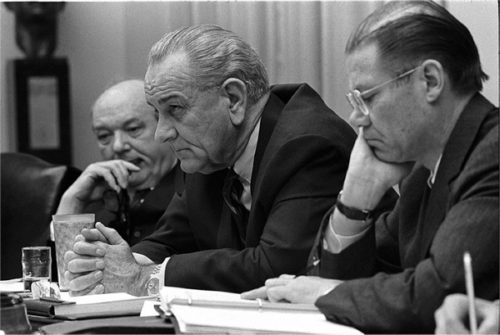
5. “There is no famine or actual starvation, nor is there likely to be.”
In the 1930s, Joseph Stalin was determined to wipe out private farms in Ukraine and put the population into Soviet controlled communes. He instituted a policy that began starving this region. Ultimately, between two and four million people starved to death. As could be expected, the Soviet government denied any problems. What is surprising is that many western reporters repeated Moscow’s interpretation of what was happening in the region.
Walter Duranty, a reporter for the New York Times, wrote repeatedly that was no famine (those are his words, above). He wasn’t the only reporter who parroted the Soviet’s line, but he was at a prestigious paper and had actually won a Pulitzer Prize for his coverage of Stalinist Russia. Duranty also justified the brutality of Stalin’s gulag system as a necessary measure that would ultimately benefit the Russian people.
Result: Duranty’s assertions that there was no actual starvation assured western leaders there was no reason to press for famine relief. His reporting helped the world turn away from the deaths and imprisonment of millions.
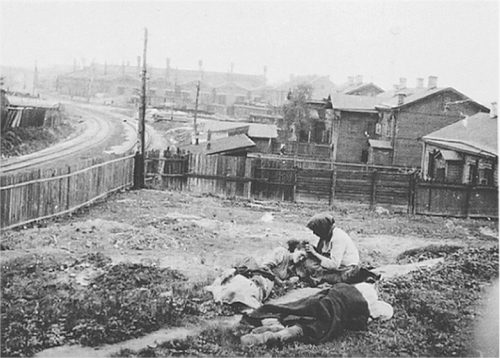
6. “The German Army was stabbed in the back.”
In 1919, General Paul von Hindenburg told the German people why they lost World War I. He said Germany hadn’t been beaten honorably on the battlefield by the enemy, but by radicals and other undesirables back home who’d overthrown the Kaiser’s monarchy and replaced it with a republic. The real reason for the defeat, Hindenburg said, was “The German army was stabbed in the back.”
In fact, the German army had thrown everything it had into one last, desperate chance for victory. By June, they had simply run out of steam. Moreover, the revolution had begun not by civilians but by members of the German military.
But the lie was swallowed by Germans who were convinced that if only the troublemakers could be silenced, Germany would regain its greatness.
Result: The lie fueled the rise of the Nazi party.
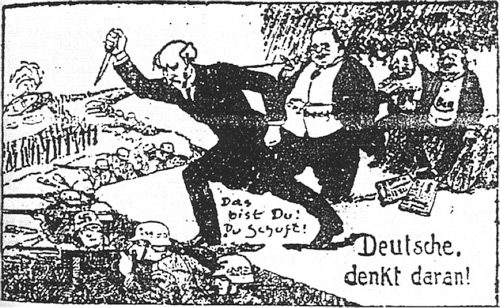
7. “The Jewish Peril: The Protocols of the Learned Elders of Zion”
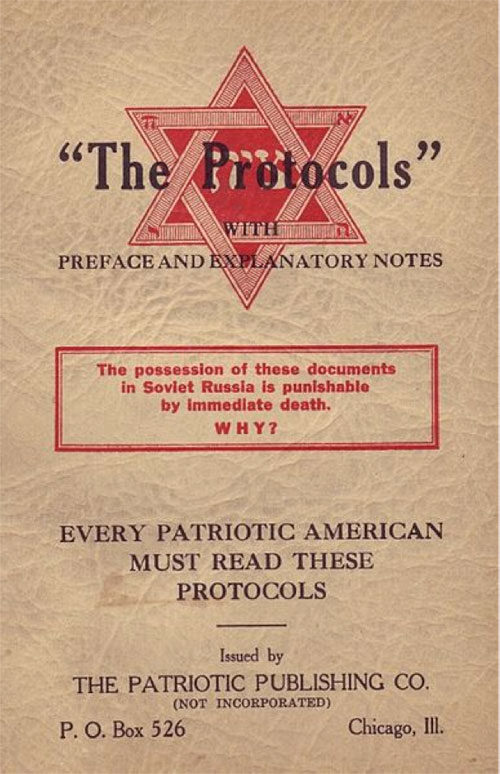
In 1905, Russian writer and mystic priest Sergei Nilus claimed that he had proof of a Jewish plan to achieve global domination by corrupting the morals of Gentiles and controlling the world’s media and money. The Jews were also plotting, he claimed, to slaughter Christian children, spread plague, and commit other atrocities.
Despite the fact that the Protocols were shown to be a malicious fabrication, many people stubbornly believed its vile slanders. Henry Ford thought it so important he paid to publish half a million copies. And the Nazis later cited it to justify their slaughter of eight million Jews.
Result: The Protocols continue to be used to fuel anti-Semitic hatred.
8. “We know Dreyfus is guilty of treason because he ‘made everything disappear.’”
In 1894, French military intelligence officers learned the Germans were receiving secret information about new French artillery. After reviewing possible suspects on the French General Staff, they accused Lt. Col. Alfred Dreyfus. His chief qualification for being suspect was his Jewish faith. He was tried by a military court, found guilty, stripped of his rank, and sent to permanent exile on Devil’s Island off the South American coast.
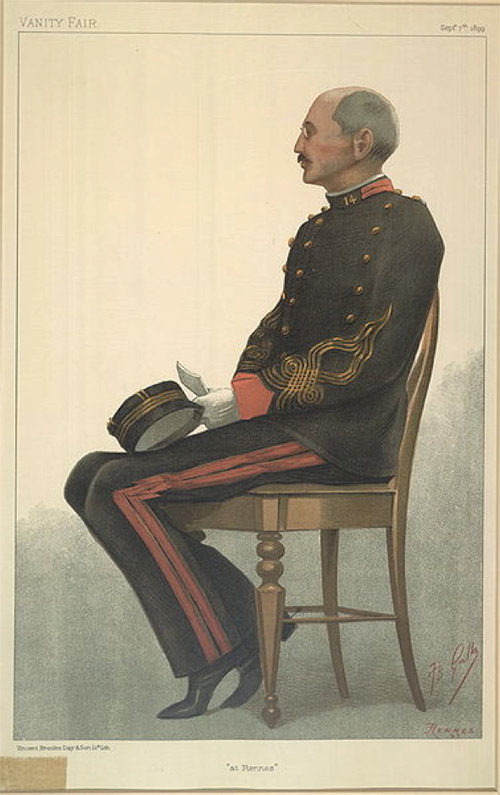
High-ranking military officials had been determined to pin the blame on Dreyfus. They had secretly supplied the judges with wholly invented evidence. And the fact that there was absolutely nothing that implicated him was actually used against him. The proof of guilt, an officer said, was that “Dreyfus made everything disappear.”
In 1896, new evidence indicated the traitor was actually another officer who was allowed to flee the country. For years, the military ignored the public outcry against Dreyfus’s conviction. Ultimately it yielded to pressure and tried Dreyfus again, and convicted him again.
Result: The lie did more than convict an innocent man. It split the country between social classes, age groups, and political parties. Even after Dreyfus accepted a pardon in 1906 rather than return to Devil’s Island, the case continued to divide the country, and this lack of unity seriously weakened its ability to defend itself in both world wars. (The French military finally proclaimed Dreyfus innocent in 1995.)
Featured image: Shutterstock
Considering History: How Immigration Laws Can Destroy American Families
This column by American studies professor Ben Railton is the first in a series that explores the connections between America’s past and present.
One of the great unknown American short stories, “In the Land of the Free [PDF]” (1912) by Sui Sin Far (Edith Maude Eaton), describes the effects of the first American immigration laws and policies on a Chinese American family. In Far’s story, Chinese American merchant Hom Hing and his wife Lae Choo have immigrated to and live in the United States at the turn of the 20th century. But Lae Choo has returned to China to care for her husband’s dying parents; while there she gives birth to their first child, a son. When she and her infant child return to her San Francisco home, they are detained by customs officers; eventually her son is forcibly taken away from her and held in a detention facility.
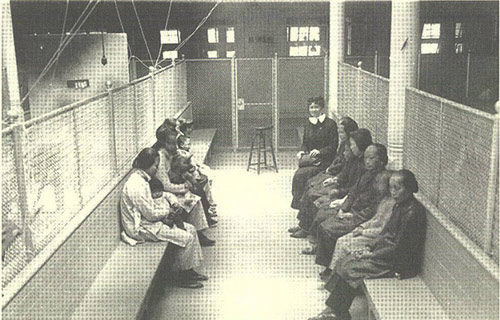
After ten long months of efforts to secure his release—“ten months since the sun had ceased to shine for Lae Choo,” Far writes—the family finally succeeds. Yet when Lae Choo reunites with her son, he “shrunk from her and tried to hide himself in the folds of the white woman’s skirt.” The story’s tragic final line is, “‘Go ‘way, go ‘way!’ he bade his mother.”
Immigration laws and policies might appear to focus entirely on new arrivals to the United States. But as exemplified by the earliest national immigration laws, the development of immigration policy has also consistently affected families and communities already in the United States. Many elements of these discriminatory first immigration laws were created precisely to disrupt both new and existing immigrant American families, and through them communities deemed less desirable or less “American.”
The first national immigration law was the Page Act of 1875 [PDF], a very specific act that defined three particular categories of arrivals as “undesirable”: those considered convicts in their prior country, forced laborers, and Asian women coming to the U.S. “for the purposes of prostitution.” The third category engaged in stereotypical (and enduring) images of Asian women as by nature “lewd and immoral” (the act’s own terms). But in an era of rising anti-Chinese sentiment, the true goal of that category was to make it more difficult for Chinese Americans to establish multi-generational families and communities: many of the first such Chinese arrivals had been men, and limiting female arrivals would thus limit such multi-generational growth.
In fact many such multi-generational Chinese American families and communities already existed in the United States as of the 1870s. The 1880 census (the first to record ethnic/national identity) identified more than 100,000 Chinese Americans, a number likely much lower than the actual one given the difficulty of documenting those living in crowded mining camps and tenement houses. Limiting future arrivals would not be enough to eliminate, or even necessarily contain, such a significant, longstanding, and rooted American community.
Which is why the next national immigration law, the Chinese Exclusion Act of 1882, went significantly further still. The act deemed virtually every category of future Chinese arrival as now illegal, including “both skilled and unskilled laborers and Chinese employed in mining.” It also made it impossible for any Chinese American to gain citizenship and stripped the citizenship of all those who had already earned it. The act’s preamble argued that Chinese immigration “endangers the good order of certain localities” within the United States, and of course such a sentiment would have to apply to present and past arrivals just as fully as future ones.
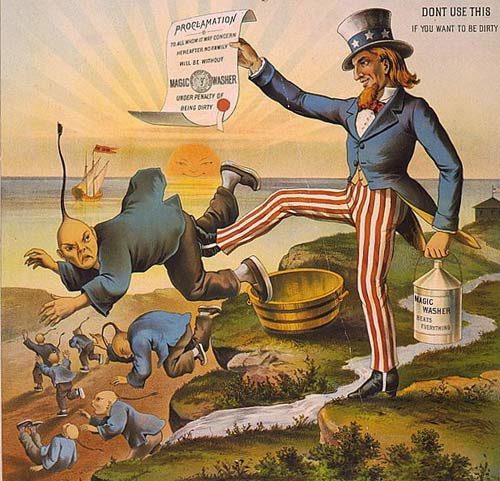
Follow-up laws in the aftermath of the Exclusion Act further clarified these goals of dismantling existing families and communities. The Scott Act of 1888 made it illegal for any Chinese American living in the United States to leave the nation and attempt to return, an odious extension of the Exclusion Act designed explicitly to sever multi-national family and community relationships and implicitly to make it far more difficult for Chinese Americans to continuing living in the U.S. The Geary Act of 1892 extended and amplified those difficulties, requiring Chinese Americans to carry at all times a “resident permit” or risk immediate deportation.
Lae Choo and her infant son in Far’s story were thus breaking the law (indeed, likely multiple post-Exclusion Act laws), making them “illegal immigrants” who were officially deserving of whatever punishment the customs officers and the government deemed appropriate. Yet Far’s story underscores two fundamental historical realities: that immigration laws have artificially constructed categories like “legal” and “illegal” through the development of particular, discriminatory immigration laws; and that those laws have been applied not only to categorize certain arrivals as “undesirable” and thus “illegal,” but also and especially to do the same for existing American families and communities.
The fictional account of Lae Choo closely parallels a multitude of actual victims of these discriminatory laws. Yung Wing, one of the 19th century’s most famous Chinese Americans, had come to the United States as a teenager, brought to Connecticut by missionaries in the late 1840s. He would go on to become the first Chinese American college graduate (graduating Yale in 1854), an American citizen, and a prominent diplomat and educator. His crowning achievement was the 1872 founding of the Chinese Educational Mission (CEM) in Hartford, a program that brought 120 Chinese young men to the U.S. Yet the school was closed in 1880 due to rising anti-Chinese sentiments, and Yung experienced even more destructive results of the Exclusion era: His citizenship was stripped and he was kept out of the country and separated from his family for years. His wife passed away and his young sons were fostered out to friends. He was never legally allowed to return to the United States.
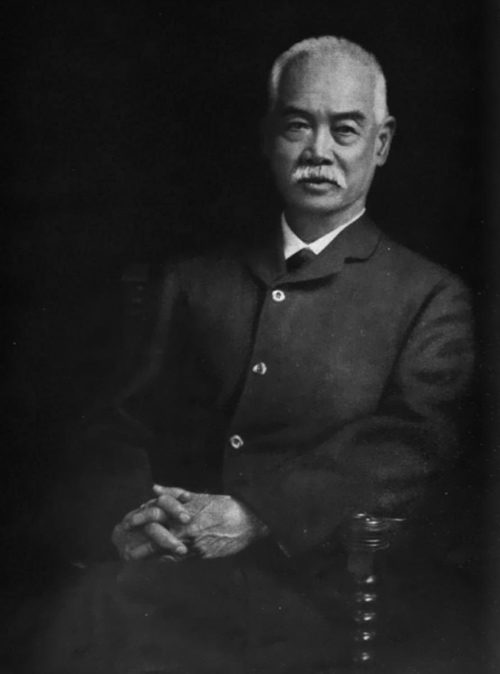
In contrast to these more exclusionary histories, America has also seen moments and laws with more inclusive visions of immigrant arrivals, families, and communities. The Immigration and Naturalization Act of 1965, for example, prioritized immigrants with existing connections in the United States, focusing on “immediate relatives” such as spouses, parents and children, grandparents, and siblings in an attempt to build upon and strengthen immigrant family and community ties. The 1965 law has made it possible for multi-generational immigrant families from many previously excluded nations and cultures—Chinese Americans among them—to once again develop and flourish in the United States.
These immigration policy choices not only affect the opportunities and experiences of new and future arrivals, but also help create and strengthen a national community in which such families and communities can exist and grow openly and successfully. Every debate over immigration law and policy, such as those unfolding in our own moment, affect American families and communities in purposeful and significant ways. Understanding past laws and how they affected families like the one depicted in “In the Land of the Free” can help us make informed and thoughtful decisions about the effects of immigration on our country and our communities.
Post Puzzlers: January 4, 1873
Each week, we’ll bring you a series of puzzles from our archives. This set is from our January 4, 1873, issue.
Note that the puzzles and their answers reflect the spellings and culture of the era.
RIDDLER
MISCELLANEOUS ENIGMA
WRITTEN FOR THE SATURDAY EVENING POST
I am composed of 49 letters.
My 21, 12, 44, 32, 5, 17, was the name of the Spaniard who first discovered that America was not a portion of the Eastern Continent.
My 25, 14, 18, 11, 46, 25, 49, 45, is the name of a planet.
My 4, 28, 41, 47, 8, was the birthplace of Columbus.
My 48, 22, 10, 6, 24, 36, 48, 16, 27, 20, is the name of a city in the United States.
My 25, 40, 13, 17, 34, 31, 39, 7, 12, 29, 28, 38, was the name of a celebrated American general during the Revolutionary War.
My 11, 26, 25, 16, 19, 49, 37, 17, is the name of a high, rocky island noted as the place of exile and death of Napoleon Bonaparte.
My 34, 23, 45, 19, 33, 38, 25, 40, 11, 6, 43, 44, 31, 23, 38, was the name of a Roman king.
My 38, 29, 3, 12, 42, 27, 14, 10, 46, 16, is the name of a river in North America.
My 48, 17, 15, 9, 38, 47, 10, was the name of a President of the United States.
My 2, 23, 46, 30, 49, 34, 35, 33, 11, was the name of a celebrated Roman poet.
My whole is quite a true maxim.
Seaboard, N. C., EUGENE.
ANAGRAMS
WRITTEN FOR THE SATURDAY EVENING POST
NAMES OF AMERICAN CITIES
South America.
- See, a boy’s run.
- Move on tide.
- Gay Laura.
- Race Lad.
- Spare pilot.
North America.
- Hill had a pipe.
- We met Sir Ned.
- Worn key.
- Labor time.
- Try to sew.
- No more.
Seaboard, N. C., EUGENE.
CHARADE
WRITTEN FOR THE SATURDAY EVENING POST
My first is often found in my second;
My whole a beautiful plant is reckon’d.
Fort Totten, D. T. GAHMEW.
WORD SQUARE
WRITTEN FOR THE SATURDAY EVENING POST
- Part of a vessel.
- A tree.
- A female name.
- Used for music.
Fort Totten, D. T., GAHMEW.
CHARADES
WRITTEN FOR THE SATURDAY EVENING POST
I.
My 1st is an instrument of punishment.
My 2d is one-third of an ell.
My 3d is often seen in newly-mown meadows.
My 4th is one of the blessings of the night.
My whole is one of Scott’s characters.
II.
My 1st is a personal pronoun.
My 2d is part of the human frame.
My 3d is a product of farms.
My whole, an improving study.
III.
My 1st is a title of respect.
My 2d is part of the verb to be.
My 3d is what we do when taking our tea.
My 4th is a popular dish.
My whole is a State in the Union.
IV.
My 1st is man, expressed in a foreign tongue.
My 2d is the author of many crimes.
My 3d is something we all have but have never seen.
My 4th is a common article.
My whole is the birthplace of many great men.
PROBLEM
WRITTEN FOR THE SATURDAY EVENING POST
If the sides of a triangle be bisected, and perpendiculars be drawn from the points of bisection to the circumference of the circumscribed circle, they will measure 10, 34 and 98 rods, respectively. Required—the diameter of the ciroumseribed and inscribed circles, and the sides of the triangle.
An answer is requested.
E. P. NORTON, Allen, Hillsdale, Co., Mich.
ANSWERS
MISCELLANEOUS ENIGMA—Ill got gains are dearly bought, retribution soon will come.
ANAGRAMS—1. Buenos Ayres; 2. Montevideo; 3. La Guayra; 4, Caldera; 5. Petrapolis; 6. Philadelphia; 7. West Meriden; 8. New York; 9. Baltimore; 10. West Troy; 11. Monroe.
CHARADE—Shad-dock.
WORD SQUARES—
SPAR
PINE
ANNE
REED
CHARADES—1. Roderick Dhu. 1. History. 3. Mississippi. 4. Virginia.
PROBLEM—170 rods the diameter of the circumscribed circle—56 rods the diameter of the inscribed circle—90, 186 and 168 rods the sides of the triangle.
Russia’s Fake News Is Nothing New
When the Post reported on Russia’s intelligence services back in 1967, the KGB’s “Department D” did not get a lot of attention. It was the height of the Cold War (the Berlin Wall had gone up only a few years earlier) and the Soviet Secret Services posed deadly threats to the West. But today “Department D” has a new relevance.
The letter “D” stood for dezinformatsiya, a word coined by Soviet premier Josef Stalin to describe a policy of generating “fake news.” The department’s mission, according to the CIA, was to “defame and discredit” the United States by planting false or misleading articles about America in the media. Each year the department turned out over 350 derogatory news items, designed to “isolate and destroy” the United States.
Dr. Jim Ludes, who recently completed a study on Russian disinformation for the Pell Center, says that back in 1967, the Russians were exploiting racial unrest in America. They planted stories in American papers claiming Martin Luther King was a collaborator and an “Uncle Tom” because they thought his push for unity would strengthen America. After he was assassinated, they used the press to stoke resentment in the black community over his death.
Fifty years later, the old KGB is gone, replaced by the FSB, which does much of the same work and answers solely to President Vladimir Putin, an ex-KGB officer. But as American intelligence organizations have reported, some form of “Department D” is still very much alive.
According to Dr. Yuval Weber of the Daniel Morgan Graduate School of National Security in Washington, D.C., Department D is run by people like Yevgeny Prigozhin, a Putin confidante who ran a “Department of Provocations” — essentially a troll farm used to spread divisive and inflammatory stories before the 2016 presidential election. Weber says, “They engage in those sorts of activities without being official members of government, and if they’re successful can seek quasi-legitimate advertising contracts to cover disinfo operations. If they’re unsuccessful, they move on. It’s like a start-up culture in a sense.”
Russian disinformation, according to New York Times reporter Neil MacFarquhar, has one fundamental goal: “undermine the official version of events — even the very idea that there is a true version of events — and foster a kind of policy paralysis.”
Russia has aimed a torrent of misinformation at the U.S. that has deepened political divisions within our country—and many others — through the creation of fake accounts and the deployment of bots. Russian disinformation has also been at the center of controversy as President Trump and some of his political allies downplay the extent of Russian mischief and interference in our political life.
The openness that characterizes U.S. society has helped the Russians. David Darrow, associate professor of Russian history at the University of Dayton, says, “Our open institutions — our free press and free market … make us stronger, but they pose risks, and the Russians have been quick to exploit them.”
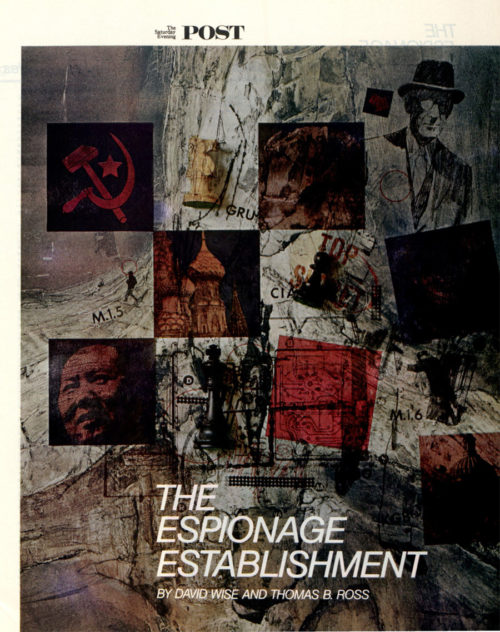
Featured image: Illustration from the “The Espionage Establishment” by David Wise and Thomas B. Ross from the October 21, 1967, issue of the Post.
‘Hell, No, We Won’t Go!’: Protesting the Vietnam Draft in 1968
[Editor’s note: This story on the Vietnam War draft was first published in the January 27, 1968, edition of the Post as “Hell, No, We Won’t Go!” We republish it here as part of our 50th anniversary commemoration of the Summer of Love. Scroll to the bottom to see this story as it appeared in the magazine.]
A big interstate bus noses into the checkpoint on the Canadian border near Rouses Point, New York Canadian customs officials come aboard, accompanied by two FBI men. The agents have fugitive warrants in their pockets, and they are looking for young Americans of draft age trying to flee the country. They tap one boy on the shoulder. …
It’s 10 a.m. in the offices of a big utility company in Chicago. Two FBI men and two federal marshals enter a supervisor’s cubicle and ask to speak with a young clerk. The youth is called out into the corridor, and the agents put him under arrest for violation of the Selective Service Act. They snap handcuffs on the young man’s wrists. …
A Pfc. is standing at attention in the orderly room of a quartermaster company at Ft. Knox in Kentucky. A reservist, he is wearing civilian clothes. His company commander says to him. “I’m giving you a direct order to put on your uniform and report for duty.” The young soldier says, “I cannot, for reasons of conscience.” The company commander orders the soldier taken to the post stockade, where he is stripped and put in a steel isolation cell. …
Two FBI men are working their way up Avenue A in New York City’s East Village hippie colony. They are asking about a boy named Johnson who failed to register for the draft in his hometown, Sacramento, Calif. and then disappeared. They walk right past Johnson without knowing it. Johnson hasn’t been Johnson for a long time. Hiding out with the hippies in San Francisco, Los Angeles, Chicago, and New York, he has used half a dozen names. In the East Village he is known simply as Scuby. …
Across the country such scenes are taking place nearly every day. “Open resistance to the draft,” says columnist Clayton Fritchey, “is greater than at any time since the Civil War.”
The anti-draft demonstrations last month in New York and elsewhere, part of a series of draft protests planned for this year and next, were merely the noisiest and most noticeable signs of the defiance. Less obvious but considerably more significant is the exodus of young Americans to Canada. According to the private groups in Canada that assist the exodus, some 10,000 men have slipped across the border to evade the draft, choosing to live as aliens and to cut themselves of from friends and family and all things familiar; if they return to the United States, they face jail sentences of up to 15 years. The Justice Department says that only 200 men have been indicted for fleeing to Canada, but the government figures are misleading. With the ponderous legal machinery of Selective Service, it takes nearly a year to get an indictment and a fugitive warrant through the courts, and the greatest flow to Canada has come in the past few months.
Altogether the Selective Service System lists 15,310 “delinquents,” men who have not responded to calls or correspondence from their draft boards. Some 2,000 of these belong to a loose national federation of draft-defying groups the one in Chicago is called CADRE (Chicago Area Draft Resisters.) The members have pledged themselves to go to prison rather than into the Army; they have turned in their draft cards and are awaiting indictment. Slowly, but with increasing speed, the Government is obliging them. In the fiscal year 1966, some 650 young men were indicted for violations of the Selective Service laws; in fiscal 1967 the number doubled. Convictions have doubled too — from 372 in 1966 to 748 in 1967. Last month the Justice Department, declaring that prosecutions were “at an all-time high,” said it was forming a “special unit” to prosecute more vigorously. There is still another factor in gauging the resistance: More than 22,000 men (not counting veterans) have won classification as conscientious objectors. The rate of conscientious objection is 70 percent greater than it was during World War II. The Selective Service people attempt to soften this by pointing out that there are only 1.7 conscientious objectors for every 1,000 registrants, and they add that only four men in every 10,000 registrants are delinquent. The key word here is registrants. By measuring the resisters against all registrants, the Government manages to disguise the magnitude of the phenomenon. The nation’s 35 million registrants include all men in the United States between the ages of 18 and 45, most of whom are overage, disabled, or deferred — that is, not eligible for the draft anyway.
But even if one accepts the official figures at face value, the problem is still a serious one. The Selective Service System, like most operations of our Government, relies to a large degree on voluntary cooperation; compulsion can go just so far. Now, for the first time in living memory, a sizable number of Americans are refusing to cooperate. Some, of course, are merely cowards trying to save their skins. And some are so intemperate in their opposition that they may be passed off as chronic misanthropes. “The FBI,” says Stuart Byczynski, a draft dodger now in Toronto, “is the new Gestapo, and the country is becoming a vast concentration camp.” But many reveal a strength of conviction that is hard to scorn. “This is my country, and I love it,” says Richard Boardman, who is waiting in Chicago to be prosecuted for draft evasion, “and I will stay here and go to jail if necessary to help correct its mistakes. I accept the general framework of the law, and I accept the penalties for breaking the law.”
The draft evaders, or “non-cooperators,” as some call themselves, vary tremendously in background. There are simple Mennonite farm boys as well as scholars with Ph.D.s. There are Negroes from the ghetto and boys from America’s richest families. Politically, they range from Maoists to Bobby Kennedy Democrats to Goldwater Republicans. It is possible, however, to group these diverse young men in six major categories.
The first is composed of those men who have gone to prison for their anti-conscription activity. These are the elite of draft-dodger society, the folk heroes of the resistance movement. Typical of them is Fred Moore Jr., who was back on the anti-war picket lines just two days after completing his two-year sentence at the Allenwood Federal Prison Camp near Lewisburg, Pa. Moore, a slight, clean-cut 26-year-old from Arlington, Virginia, is a Quaker and a follower of Mahatma Gandhi. He regards himself as an out-and-out pacifist and says he would not even defend himself if attacked.
In 1959 Fred Moore was expelled from the University of California for refusing to participate in the ROTC, which was then compulsory. He joined an organization called the Committee for Non-Violent Action and lived for a time on its farm in Voluntown, Connecticut, helping to raise food for the members and joining in their endless discussions of Gandhi’s principles. He went along on the organization’s “Friendship March to Cuba,” which foundered when the Coast Guard intercepted its boat off Miami.
In 1962 Moore’s draft board classified him 1-A. That prompted him to apply for conscientious-objector status (classification 1-O) so that instead of soldiering he could work in a civilian hospital or a social-service agency. Normally, a youth of Moore’s religious beliefs receives the 1-O classification fairly routinely, but he objected to some of the phrasing in the government form. He crossed out the words “Supreme Being” and substituted “God, which is the power of love.” Moore was investigated by the FBI and had to appear before a hearing officer to explain his religious convictions. In April, 1964, he received his 1-O classification.
“I had a strange reaction to the notice,” Moore says. “I had no feeling of relief or gladness. Instead, I had the feeling that I was a moral coward, and that I had ended up cooperating with the Selective Service System in order to get special status for myself.” He sent his classification card back to his draft board, informing it that it was participating in “the march toward totalitarianism.” He then hit the road, lecturing on peace at college campuses all over the country. He wore sandwich boards reading, LIBERTY YES. CONSCRIPTION NO, THOU SHALT NOT KILL, and DON’T DODGE THE DRAFT; OPPOSE IT.
His protesting ended in June, 1965, when two FBI men came to see him at Pendle Hill, a Quaker study center in Pennsylvania. The government agents told him that they had been sent to give him a last chance. They practically pleaded with him to go to Richmond, where he had been assigned by his draft board to do his alternative service — hospital work. Moore thanked them politely and said no. A few days later he received a registered letter ordering him to surrender himself at the United States courthouse in Alexandria, Va. He did so and went on trial for draft evasion on October 21, 1965.
On his way to the trial he picketed the White House and distributed pacifist leaflets outside the court building. Refusing court-appointed counsel and electing to defend himself, he told Judge Oren R. Lewis that he couldn’t plead guilty because the draft was on trial and not he. His defense was that conscription was unconstitutional because it represented involuntary servitude, as defined by the 13th Amendment. Moore says, “The judge was hostile at first, but then he began to realize I was sincere and trying to live according to my beliefs. He even said so.” The trial lasted three hours. Moore was found guilty and sentenced to two years in the federal penitentiary.
The youth waived his right of appeal and began to serve his time almost immediately on the Allenwood prison farm. There were 80 other Selective Service violators there at the time. “The first six months were the hardest,” Moore says. “I got into an argument with a forger over a program I wanted to see on the television set, and he knocked out my two front teeth. After that I learned that the idea is to do your own time and not bother anyone else. I worked in the prison garden in the daytime, and at night I read or played the guitar and sang folk songs with the other Selective Service violators. Time wasn’t easy, but I learned to adjust to it.” In April, 1967, he was released seven months early on automatic “good time.” He could have been released earlier, but he refused to cooperate with the parole system.
Moore today is back at the old stand, demonstrating against the Vietnam war and counseling opposition to the draft. He has gone to work as office manager for a group called Quaker Action, which dispatches boatloads of medical supplies to both North and South Vietnam, and has married Suzanne Williams, a 19-year-old peace demonstrator who has been arrested and jailed no less than seven times. Moore already has burned his new 1-O draft card, which was sent to him after he got out of jail, and he fully expects to be prosecuted a second and maybe even a third time. He says, almost casually, “I’m perfectly willing to go to jail again for my beliefs.” A Justice Department official says, “This boy is either nuts or so goddamn sincere you have to respect him — but what can we do but throw the book at him again?”
Less sincere and more elusive is the second category of draft evaders, “the Underground.” These are the young men, registered and unregistered, who hide out in the ghettos and hippie colonies of the major American cities. No one in the Government will even guess at how many of them there are, but the Central Committee for Conscientious Objectors in Philadelphia estimates that they probably number in the thousands. Certainly they make up a good proportion of the 15,310 Americans listed as “delinquent” by Selective Service.
Many in the Underground have been runaways and “floaters” since their late teens. The Negro youngsters wander from tenement to tenement in the ghettos, where itinerant boarders are common, and no questions are asked. The whites are hippies or disguise themselves as hippies and blend into the anonymity of “crash-pad” living.
In New York’s East Village, the Underground member named Scuby was sitting in a delicatessen eating a pastrami sandwich. “Man,” he said, “there are fifty of us within two blocks of here.” A few minutes before, the two FBI men had passed him without recognizing him; they were showing his picture to shopkeepers and asking for him by the name of Johnson. But the picture was not recent, and Scuby now has a full, reddish beard and wears dark glasses.
He spoke of his background — he came from a “typical middle-class materialistic family,” and when he first “took off,” as he put it, he joined the hippie colony in Venice, Calif. Afterward he floated to other hippie settlements around the country, leaving no trail and never once telling his family where he was. “My father’s a fink,” he said. “He’d turn me in to the feds.”
Scuby doesn’t participate in hippie demonstrations or anti-war protests. “The idea is to play it cool,” he said, “and never do anything to call attention to yourself. Another thing you got to be careful about is not to get high on acid, because you might lose control and say something to give yourself away. You never know who’s a fink for the feds.” Scuby expressed no convictions about pacifism or the Vietnam war. He simply said, “I got better things to do than get shot at by a bunch of Viet Congs.”
Many of the young men in the third major category of draft resisters — those who leave the country — share Scuby’s nonideological, live-and-let-live attitude. This reporter encountered a high percentage of misfits among the fugitives in Canada. Many had records of family conflict and had moved often from one school to another. Nearly all had had 2-S student deferments and hadn’t thought seriously about their personal convictions until the 2-S was revoked. At least a dozen youths claimed they had considered going to jail but had decided against it on the grounds that they just weren’t up to it.
Canada is a natural haven for these young men. Some flee to France or South America, but most find it simplest to cross the Canadian border, knowing that Canadians on the whole are not enthusiastic about the Vietnam war, and that Canada will extradite criminals only for offenses that are also illegal in Canada — since Canada has no draft, draft evasion is not a crime there. Vancouver is an entry point for West Coast evaders and Montreal for fugitives from the East Coast. But, except for menial jobs, employment in Vancouver is tightly controlled by the unions, and the use of French in Montreal presents a language problem for the average American. So Toronto, a cosmopolitan, English-speaking city with an American flavor, has become the center of the draft-dodger community.
One of the more impressive of the Toronto refugees is John Phillips, a tall, blond, 22-year-old Quaker from Algona, Iowa. Phillips’s pacifism is founded in his religion, and ordinarily he would have had little trouble obtaining the conscientious-objector classification he applied for. But he bewildered the five farmers on his rural draft board; he was the first objector they had encountered, and they didn’t know what to make of him. “They called me a coward and a Communist,” Phillips says, “and when they learned I had covered the Selma, Alabama, civil-rights march as a photographer, they said, ‘Oh, so you went down there to help those niggers.’ I told them I’d go to Vietnam as a combat photographer, anything so I wouldn’t have to kill, but they didn’t believe me. For the first time in my life I broke down and cried.”
Phillips filed an appeal and went so far as to report for his preinduction physical examination. He spent the night in a barracks at Fort Des Moines, where the other draftees — until they were stopped by an officer — tried forcibly to shave him from head to toe. That decided Phillips. He married his fiancée, also a Quaker, and they left immediately for Canada. Today his wife, Laura, is a social worker in the Toronto slums, and Phillips is a photographer for an agency of the Canadian Government.
Another young man who made his decision under duress is 22-year-old Michael Miller (not his real name). A student at Penn State and the City University of New York, Miller developed such strong convictions about the U.S. involvement in Vietnam that he refused to cooperate with the Selective Service — even though he has a physical disability that probably would have kept him out of the Army anyway. He decided to go to jail, and his father, a bombardier in the Army Air Corps in World War II, called him a Communist and kicked him out of his house. Then Miller’s wife, who was pregnant, told him that his going to jail would be unfair to her, so they went to Canada. Miller genuinely grieves about his permanent exile from the United States. “I miss being out of the mainstream,” he says. “I miss not being able to go to my parents’ twenty-fifth wedding anniversary and my sister’s wedding. I miss not being able to go home again.”
But Miller’s attitude is not a common one in Toronto. Most of the draft dodgers there have turned against their country completely. They make statements like “They ought to tear down the Statue of Liberty because it doesn’t mean anything anymore.” The left-wing draft dodgers say they don’t want to live in the United States anymore because it has become a “fascist dictatorship no better than Hitler’s Germany.” The right-wingers say they have fled from “a collectivist tyranny no better than Soviet Russia.”
Typical of the latter is 20-year-old Stuart Byczynski, a thin, intense, balding young man who wears glasses. Byczynski was born into a rigid, Catholic, New Deal-Democrat family in Parkville, Maryland, but was in constant revolt against his parents’ religious and political beliefs. He left the Catholic Church and became a Unitarian when he was 17, and in 1964 he campaigned for Barry Goldwater and other conservative Republicans.
“I believe in the freedom of the individual,” he said, “and Big Government in the United States is taking away all our freedoms. It bleeds us to death with taxes, it tells us at what age we can drink whiskey and drive a car, it spends a lot of money forcing artificial racial equality. Even while I was still in high school, I decided no government was going to tell me I couldn’t pursue my chosen profession and would have to sleep on cots with a lot of other people. My sole reason for going to college was to avoid the draft as long as possible with a 2-S student deferment.”
At the University of Baltimore, he did well for four semesters, but then fell from the top third of his class and lost his deferment. He filed an appeal but only to gain a delay until May, 1967, when he had scheduled his flight across the border. On May 21 he rented an apartment in Baltimore and moved out of his parents’ home, telling them that he wanted to live alone for the summer. On May 28 he took a circuitous route to the Baltimore bus station and, to foil the FBI, bought a round-trip ticket. But the FBI never came near him. He arrived in Montreal on May 29, celebrated his 20th birthday alone at the YMCA, and then took another bus to Toronto. There he contacted the Toronto Anti-Draft Programme, which provides legal advice, money, room and board, and an employment service for newly arrived fugitives from the U.S. The organization, run by American draft dodgers but financed mostly by Canadian peace groups, advised him to go back to Buffalo, New York, by plane, and then reenter Canada as an immigrant through the Toronto airport. He did so and then told his parents what he had done. “Their reaction,” he said, “was ‘Sob, sob, where have we gone wrong?” Today Byczynski is working as a reporter for a newspaper in a small city in Ontario. He makes less money than he did in the United States, but, he says, “the taxes are lower, and this country is freer.” Says a former employer in Baltimore: “I’m not surprised at what Stuart did. He always was trying to escape from reality.”
The war resisters in the fourth category do not generally enjoy the luxury of escape. These are the young men who have already entered the armed forces and then decided they couldn’t fight in Vietnam. Their only recourse is to desert (which very few do), or to apply for a conscientious-objector discharge (which are rare; the Army approves less than five percent of the applications). If the young man persists, the usual result is a prison term for disobeying orders. The Department of Defense says it has about 400 C.O. applications pending. The Central Committee for Conscientious Objectors insists, on the basis of its correspondence from servicemen seeking legal help, that the figure is much higher.
One of the most interesting cases in this category involved Michael Wittels, who now is 28 years old and a successful young artist in Philadelphia. Wittels, never a peace activist or protester during his years at Cheltenham High School and the Philadelphia College of Art, joined the Army Reserves and was assigned to a quartermaster company in 1962. His six months of active duty at Fort Knox, Kentucky, were uneventful. He was a good soldier and was promoted to squad leader when the company took heavy weapons training at Fort Polk, La. “But suddenly,” Wittels told me, “the whole thing jumped up and hit me in the face. An instructor was demonstrating a new rifle, and he said, ‘This weapon can tear a hole the size of a fist in a man.’ At that moment I knew I could never kill — that I was a conscientious objector at heart.”
Wittels finished his active duty, but he continued to brood about his convictions, even while faithfully attending his reserve meetings. Finally, in June, 1965, he sought legal advice from the Friends Peace Committee and learned that he could apply for a conscientious-objector discharge. He painstakingly filled out the complicated application, and on August 25, 1965, he turned it in to his company commander.
Six months went by and Wittels heard nothing about the application, though he kept writing to all the higher reserve echelons. In January, 1966, he stopped going to reserve meetings and returned his Army pay checks. In March, the application was turned down. Then he was demoted from Pfc. to Private and, as a punishment, was ordered to report to Fort Knox for 45 days of active duty. He did so, arriving in civilian clothes. He explained his position to his new company commander, a young Negro officer named Capt. Albert Thurmond. “He was very kind and polite,” said Wittels, “but he didn’t know what to do about me, since I told him I could not put on my uniform and serve. He sent me to see the adjutant general and two chaplains. They all tried to talk me into taking the easy way out by putting on my uniform and serving the forty-five days. They didn’t even seem to listen when I told them I would not retreat from my stand.”
After three days, according to Wittels, Captain Thurmond called him into the orderly room, sighed, and gave him a direct order to put on his uniform and report for duty. When Wittels respectfully refused, he was taken to the stockade, where a sergeant told him, “We’ve had your kind in here before, and we’re going to break you.” He was stripped of his shirt, shoes and socks and locked in “The Box,” a 6-by-8-foot isolation cell with nothing in it but a Bible and a steel slab for a bunk. The guards kept him standing until 2 a.m., when he was sent to take a shower. When he got back to the cell, his blanket was gone. It was a cold night, but a guard said, “You don’t want that blanket. It says U.S. Army on it.”
Wittels says he was in “The Box” for three days, during which he was fed bread, dry cereal, and cabbage. On the third day the confinement officer, a six-foot, seven-inch Negro captain named Wyatt Minton, came to see him. “Just put on the regular stockade fatigue shirt, not your uniform, and I’ll let you out of here. I need the space.” Wittels agreed, and was put in a 24-man cell with the general prison population. There were eight other C.O.’s in the stockade. Two weeks later he went on trial for disobeying his company commander’s direct order to put on his uniform. He was found guilty and sentenced to six months at hard labor. Wittels was returned to a solitary cell on the grounds that “he would contaminate the other prisoners.” The quarantine didn’t work. The other prisoners and even the guards came to admire Wittels’s uncomplaining courage, and they smuggled food and books in to him. Six weeks later Captain Minton sent for Wittels. “I hear you’re a damned fine artist,” he said. “I’m going to let you out around the base to do paintings to decorate the stockade. All you have to do is sign a statement saying you’ll obey stockade rules.” Wittels signed the statement.
On February 6, 1967, the end of his sentence, Wittels was released from the stockade. He went back to his Fort Knox company where an officer again ordered him to put on his uniform and report to a duty station. Again Wittels refused, and he was returned to the stockade. This time Wittels faced a general court-martial and a sentence of five years at Fort Leavenworth. He was made a maximum-custody prisoner, often with handcuffs and an armed guard.
But without his knowledge a series of events were taking place far from Fort Knox. Wittels’s mother had appealed to Congressman Richard S. Schweiker, a Republican from Pennsylvania, who demanded that the Army investigate. The Army told him it was processing Wittels’s new application for a conscientious-objector’s discharge. And then a hearing officer ruled that the charge pending against Wittels was unsupported. He was released to perform noncombatant duties on the base. After 26 days Wittels was sent home. In July, 1967, he received a general discharge “under honorable conditions … by reason of conscientious objection.” Later one of the Fort Knox stockade guards wrote to him: “What you went through here took more guts than going to Vietnam.”
Wittels, of course, could have avoided his ordeal if he had obtained conscientious-objector status before going into the Army. This type of war resistance is perfectly legal. The more than 22,000 men who have been classified as C.O.’s by their draft boards make up the fifth and sixth categories of war resisters — the two kinds of legitimate C.O.’s recognized by the Selective Service System.
One kind is the men who are classified 1-A-O. The 1-A-O’s go into the Army as draftees along with the 1-A’s, but they are not required to handle weapons, and they perform only noncombatant duties, usually in the Medical Corps. Members of churches such as the Seventh-Day Adventist almost automatically get 1-A-O status from their draft boards when they apply for it; others have to prove their case. All 1-A-O’s — there are 4,500 of them — take their basic training in two 400-man companies in the Army Medical Training Center at Fort Sam Houston in San Antonio, Tex. They are treated the same as other soldiers, except that they get no weapons training. After training, most are assigned as medical corpsmen with Army units in the field, including Vietnam. Col. C. C. Pixley, commander of the Army Medical Training Center, says, “These people are among the best soldiers I have ever known.”
Sgt. Richard Enders epitomizes the C.O. in the Army. A Seventh-Day Adventist from Longview, Washington, Enders was classified 1-A-O and sent to Fort Sam Houston. From there he went to Vietnam and was assigned to the 346th Medical Dispensary in Can Tho, the heart of the Viet Cong-infested Mekong Delta. Enders not only tended wounded GI’s but consistently volunteered for expeditions on which teams of Army Medical Corps specialists go into the countryside under heavy guard and treat the civilian population in Vietnamese villages. There was only one other C.O. in Enders’s outfit, but, he says, “no one thought of us as being different from anyone else.”
Getting to be a 1-O, the other type of legitimate conscientious objector, is a bit more complicated. The 1-O, after he receives that classification from his draft board, does not serve in the Army but puts in two years of so-called “alternative service” as a civilian. The type of work he does is severely restricted and must be approved by the draft board. Usually it’s duty of some sort in a civilian hospital or social-service agency. Although 1-O’s outnumber 1-A-O’s by about four to one, most draft boards are loath to give the classification. Some refuse to give 1-O’s at all, even to bona fide members of pacifist religions; the feeling is that anyone taking such a stand is either a coward or a traitor. The conscientious objector’s only recourse then is to appeal. Appeals can be expensive, and those who do not have the money often become draft dodgers even though they are anxious and willing to fulfill their obligation by doing legitimate “alternative service.” An official of the American Friends Service Committee remarks that a large proportion of draft evasion is precipitated by “senile, bumbling, bigoted draft-board members.”
When Robert Whitford, a young Quaker of Madison, Wisconsin, received his 1-O classification, his draft board asked him to list three choices of work assignments. If these were not satisfactory, the draft board itself would make an assignment. They accepted Whitford’s first choice, however. Because of his knowledge of Spanish, he wanted to work with Casa Central, a social-service agency for the Spanish-speaking poor of Chicago. “I’m lucky,” he said. “Most draft boards will approve nothing but bedpan handling in hospitals.” Whitford gets $400 a month for running an “outpost” for Casa Central in a Cuban-Puerto Rican neighborhood. “Many of my friends in the resistance think that I’m copping out. They say I should have gone to jail. Why is going to jail better than doing something constructive for society?”
As Whitford’s comment suggests, the war resisters are often in conflict with each other. The 1-O’s consider the 1-A-O’s to be “cop outs,” and the resistance people, those who are awaiting jail sentences, feel similarly about the 1-O’s. All three groups revile the Underground and the refugees in Canada as lacking courage and “thinking only of themselves instead of the issues.” The resisters who follow Gandhi’s teachings believe that the only workable program is to fill the jails with sincere, educated, nonviolent war resisters who peacefully turn in their draft cards — until troubled public opinion forces the Government to change its policies. They complain that the Government is not cooperating. One resistance youth told me, “The Justice Department could arrest and convict two thousand of us tomorrow, but they’re waiting until after the 1968 elections, so the people don’t know how many of us there are.” Assistant Attorney General Fred Vinson Jr. calls this nonsense. He says, “We’re prosecuting these cases to the full extent of the law — but it takes time if we’re going to give these men the full protection of the law.” Some judges give light sentences or probation to convicted draft violators; others throw the book at them with up to 10 years in jail. A federal judge in Georgia recently meted out two consecutive five-year sentences to Clifton Haywood, the heaviest penalty given to a Selective Service violator since World War I.
There is no question that resistance is spreading — especially among the more highly educated. Jeremy Mott, a Harvard student from Ridgewood, New Jersey, was safely at work in a Church of the Brethren hospital as a 1-O, when he burned his draft card publicly in New York and helped found the group called Chicago Area Draft Resisters. He is now awaiting his arrest and jail sentence.
David McCarroll, who has degrees from Princeton and the University of Virginia, is in medical training as a 1-A-O at Fort Sam Houston. In the presence of his commanding officer he told me, “I’m totally against the war in Vietnam, and if I’m sent there I’ll have to make up my mind about going to prison instead.”
Even some of the runaways to Canada are returning to the United States in order to make a less comfortable, more forceful protest. When I interviewed 25-year-old Tom Zimmerman of Pittsburg, Kansas, he was teaching in a Toronto high school and seemed happy in his life of exile. But on December 5 he appeared in the U.S. Attorney’s office in Kansas City. He could get up to five years in prison for draft evasion, but he probably will not be prosecuted for international flight to avoid federal prosecution (an additional 10 years), because he returned voluntarily. “I felt impotent in Canada,” Zimmerman says. “Being up there just created tension for me, because all of us in Toronto were out of the mainstream of protest. I want to preserve my conscience, so I am ready to go to prison.”
As a Justice Department official told me, “I know most Americans wouldn’t agree, and certainly the fighting men in Vietnam don’t think so, but these boys, some of our brightest young men, represent the agony of our age.”
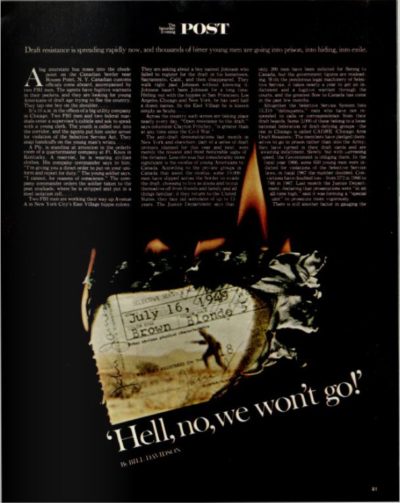
This article is featured in the July/August 2017 issue of The Saturday Evening Post. Subscribe to the magazine for more art, inspiring stories, fiction, humor, and features from our archives.
Joe College Is Dead: The Root of Student Unrest in the 1960s
[Editor’s note: Arthur Schlesinger Jr.’s “Joe College Is Dead” was first published in the September 21, 1968, edition of the Post. We republish it here as part of our 50th anniversary commemoration of the Summer of Love. Scroll to the bottom to see this story as it appeared in the magazine.]
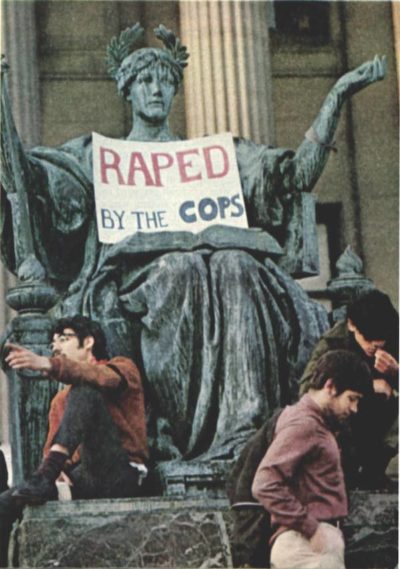
Miriam Bakser, © SEPS
Throughout our history, our sons and daughters have been the bearers of our aspirations, commissioned by birth to fulfill our dreams. Today, more than ever before in any country, the indispensable climax of the children’s preparation — and the parents’ hope — is college. “Going to college” is now considered the key to life — the key not only to intellectual training but to social status and economic success.
The United States today has nearly 6 million college students — 46 percent of all young people from 18 to 21. By 1970 we are expected to have 7.5 million — which means that our student population will have more than doubled in the single decade of the ’60s. Yet, the more college students we have, the more baffling they seem to become. For years, adults saw college life in a panorama of reassuring images, derived from their own sentimental memories (or from the movies) — big men on campus, fraternities and sororities, junior proms, goldfish swallowing, panty raids, winning one for the Gipper, tearing down goalposts after the Big Game, homecoming. College represented the “best years of life,” a time of innocent frivolity and high jinks regarded by the old with easy indulgence. But the familiar stereotypes don’t work anymore. The new undergraduate seems a strange, even a menacing, phenomenon, consumed with mysterious resentments, committed to frenetic agitations.
Many adults look on college students today as spoiled and ungrateful kids who don’t know how lucky they are to be born in the greatest country on earth. Even men long identified with liberal views find the new undergraduate, in his extreme manifestations, almost unbearable. The hard-working student, Vice President Hubert Humphrey tells us, “is being replaced on our living-room televisions by the shouter of obscenities and hate.” President Nathan M. Pusey of Harvard speaks of “Walter Mittys of the left … [who] play at being revolutionaries and fancy themselves rising to positions of command atop the debris as the structures of society come crashing down.” George F. Kennan talks of “banners and epithets and obscenities and virtually meaningless slogans … screaming tantrums and brawling in the streets.” Yet the very magnitude of student discontent makes it hard to blame the trouble on individual malcontents and neurotics. A society that produces such an angry reaction among so many of its young people perhaps has some questions to ask itself.
Obviously most of today’s students came to college to prepare themselves to earn a living. Most still have the same political and economic views as their parents. Most, until 1968, supported military escalation in Vietnam. Most believe safely in God, law and order, the Republican and Democratic parties, and the capitalist system. Some may even tear down goalposts and swallow goldfish, if only to keep their parents happy.
Yet something sets these students apart from their elders — both in the United States and in much of the developed world. For this college generation has grown up in an era when the rate of social change has been faster than ever before. This constant acceleration in the velocity of history means that lives alter with startling and irresistible rapidity, that inherited ideas and institutions live in constant jeopardy of technological obsolescence. For an older generation, change was still something of a historical abstraction, dramatized in occasional spectacular innovations, like the automobile or the airplane; it was not a daily threat to identity. For our children, it is the vivid, continuous, overpowering fact of everyday life, suffusing every moment with tension and therefore, for the sensitive, intensifying the individual search for identity and meaning. The very indispensability of a college education for success in life compounds the tension; one has only to watch high-school seniors worrying about the fate of their college applications.
Nor does one have to be a devout McLuhanite to accept Marshall McLuhan’s emphasis on the fact that this is the first generation to have grown up in the electronic epoch. Television affects our children by its rapid and early communication to them of styles and possibilities of life, as well as by its horrid relish of crime and cruelty. But it affects the young far more fundamentally by creating new modes of perception. What McLuhan has called “the instantaneous world of electric informational media” alters basically the way people perceive their experience. Where print culture gave experience a frame, McLuhan has argued, providing it with a logical sequence and a sense of distance, electronic communication is simultaneous and collective; it “involves all of us all at once.” This is why the children of the television age differ more from their parents than their parents differed from their own fathers and mothers. Both older generations, after all, were nurtured in the same typographical culture.
Another factor distinguishes this generation — its affluence. The postwar rise in college enrollment in America, it should be noted, comes not from any dramatic increase in the number of youngsters from poor families but from sweeping in the remaining children of the middle class. And for these sons and daughters of the comfortable, status and affluence are, in the words of student radical leader Tom Hayden, “facts of life, not goals to be striven for.” This puts many students in a position to resist economic pressures to buckle down and conform. As another radical has written, “Our minds have been let loose to try to fill up the meaning that used to be filled by economic necessity.”
The velocity of history, the electronic revolution, the affluent society — these have given today’s college students a distinctive outlook on the world. And a fourth fact must not be forgotten: that this generation has grown up in an age of chronic violence. My generation has been through depressions, crime waves, riots and wars; but for us episodes of violence remain abnormalities. For the young, the environment of violence has become normal. They are the first generation of the nuclear age — the children of Hiroshima. The United States has been at war as long as many of them can remember — and the Vietnam war has been a particularly brutalizing war. Most students have come to feel that the insensate destruction we have wrought in a rural Asian country 10,000 miles away has far outrun any rational assessment of our national interest. Within the United States, moreover, they have lived with the possibility, as long as many of them can remember, of violence provoked by racial injustice. Even casual crime has acquired a new dimension. Some have never known a time when it was safe to walk down the streets of their home city at night. Above all, they have seen the assassinations of three men who embodied the idealism of American life. The impact of this can hardly be overstated. And — let us face it — our national reaction to these horrors has only strengthened their disenchantment: brief remorse followed by business as usual and the National Rifle Association triumphant.
The combination of these factors has given the young both an immediacy of involvement in society and a sense of their individual helplessness in the face of the social juggernaut. The highly organized modern state undermines their feelings of personal identity by threatening to turn them all into interchangeable numbers on IBM cards. Contemporary industrial democracies stifle identity in one way, Communist states in another, but the sense of impotence is all-pervasive among the young. So too, therefore, is the desperate passion to reestablish identity and potency by assaults upon the system.
Such factors have set off the guerrilla warfare of students against the existing structures of society not only in the United States but throughout the developed world. (Student unrest in underdeveloped countries is more predictable and has different sources.) Uprisings at Berkeley and Columbia are paralleled by uprisings at the Sorbonne and Nanterre, in the universities of England and Italy, in Spain and Yugoslavia and Poland, in Brazil and Japan and China. Every country can offer local grievances to detonate local revolts. But these are only the pretexts for the rebellion. They are the visible symbols for what the young perceive as the deeper absurdity and depravity of their societies.
American undergraduates first fixed on racial injustice as the emblem of a corrupt society. But in the last two years, resistance to the draft has provided a main outlet for undergraduate revolt.
Until very recently, most college students supported the war in Vietnam — so long as other young men were fighting it. It used to exasperate Robert Kennedy when he asked college audiences in 1966 and 1967 what they thought we should do in Vietnam — hands waving for escalation — and then asked what they thought of student deferment — the same hands waving for a safe haven for themselves. At last, as the draft began to cut deeper, the colleges began to think about the war; and the more they thought about it, the less sense it made.
No one should underestimate the magnitude of this new anti-draft feeling. In 1968, I have not encountered a single student who still supports military escalation in Vietnam. Not all students who hate the war burn draft cards or flee to Canada. Many — and this may be as courageous a position as that of defiance — feel, after conscientious consideration, that they must respect laws with which they disagree, so long as the means to change these laws remain unimpaired. Yet even they regard with sympathy their friends who choose to resist. One who is himself prepared to go to Vietnam said to me, “Every student wants to avoid the draft. Every student, realizing that the method to this end is very individual, respects any method that works — or attempts that do not.”
The anti-draft revolt somewhat diminished this year after President Johnson’s March 31st speech, the Paris negotiations and the McCarthy and Kennedy campaigns. But it will resume, and with new ferocity, if the next President intensifies the war. In April, The New York Times carried a four-page advertisement headed: “We, Presidents of Student Government and Editors of campus newspapers at more than 500 American colleges, believe that we should not be forced to fight in the Vietnam war because the Vietnam war is unjust and immoral.” In June, a hundred former presidents of college student bodies joined campus editors to declare, “We publicly and collectively express our intention to refuse induction and to aid and support those who decide to refuse. We will not serve in the military as long as the war in Vietnam continues.”
However, if we Americans blame the trouble on the campuses just on the war (or, to take another popular theory, on permissive ideas about childrearing), we will not understand the reasons for turbulence. After all, the students of Paris were not rioting against a government that threatened to conscript them for a war in Vietnam; nor are the students of Poland, Spain, and Japan in revolt because their parents were devotees of Dr. Spock. The disquietude goes deeper, and it was well explained by, of all people, Charles de Gaulle. The “anguish of the young,” the old general said after his own troubles in June with French students, was “infinitely” natural in the mechanical society, the modern consumer society, because it does not offer them what they need, that is, an ideal, an impetus, a hope, and I think that ideal, that impetus, and that hope, they can and must find in participation.
Not every American student exemplifies this anguish. It appears, for example, more in large colleges than in small, more in good colleges than in bad, more in urban colleges than in rural, more in private and state than in denominational institutions, more in the humanities and social sciences than in the physical and technological sciences, more among bright than among mediocre students. Yet, as anyone who lectures on the college circuit can testify, the anguish has penetrated surprisingly widely — among chemists, engineers, Young Republicans, football players, and into those last strongholds of the received truth, the Catholic and fundamentalist colleges.
How to define this anguish? It begins with the students’ profound dislike for the impersonal society that produced them. The world, as it roars down on them, seems about to suppress their individualities and computerize their futures. They call it, if they vaguely accept it, “the rat race,” or, if they resist it, “The System” or “The Establishment.” They see it as a conspiracy against idealism in society and identity in themselves. An outburst on a recent Public Broadcast Laboratory program conveys the flavor. The System, one student said, hits at me through every single thing it does. It hits at me because it tells me what kind of a person I can be, that I have to wear shoes all the time, which I don’t have on right now. … It hits at me in every single way. It tells me what I have to do with my life. It tells me what kind of thoughts I can think. It tells me everything.
Another student added, with rhetorical bravado, “Regardless of what your alternatives are, until you destroy this system, you aren’t going to be able to create anything.”
The more typical expression of this mood is private and quiet. It takes the form of an unassuming but resolute passion to seize control of one’s own future. My generation had the illusion that man made himself through his opportunities (Franklin D. Roosevelt); but this era has imposed on our children the belief that man makes himself through his choices (Jean-Paul Sartre). They now want, with a terrible urgency, to give their own choices transcendental meaning. They have moved beyond the Bohemian self-indulgence of a decade ago — Allen Ginsberg and Jack Kerouac. “We do not feel like a cool swinging generation,” a Radcliffe senior said this year in a commencement prayer. “We are eaten up by an intensity that we cannot name. Somehow this year, more than others, we have had to draw lines, to try to find an absolute right with which we could identify ourselves. First in the face of the daily killings and draft calls … then with the assassinations of Martin Luther King and Senator Kennedy.”
The contemporary student generation can see nothing better than to act on impulses of truth: “Ici, on sponlane,” as a French student wrote on the walls of his college during the Paris insurgency. They are going to tell it, as they say, like it is, to reject the established complacencies and hypocrisies of their inherited existence. One student said to me:
Basically, the concept of this “do your thing” bit, as ludicrous as it sounds, may be the key to the matter. What it means is similar to Mill’s On Liberty because it allows anybody to do what he wants to do as long as it does not intrude on anyone else’s liberty. Therefore, nobody tries to impose anything on anybody, nor do they not accept a Negro, a hippie, a clubby, etc. I really believe that today we see beyond superficial appearances and thus, in the end, will have a society of very divergent styles, but it will be successfully integrated into a really viable whole. . . . We test out old thoughts and customs and either dispose of them or retain them according to their merits.
Along with this comes an insistence on openness and authenticity in personal relationships. A 1968 graduate — a girl — puts it clearly:
I think in personal conduct people admire the ability to be vulnerable. That takes a certain amount of strength, but it is the only thing which makes honesty and openness possible. It means you say the truth and somehow leave open a part of your way of thinking. Of course, you cannot be vulnerable with everyone or you would destroy yourself — but it is the willingness to be open, not just California-cheerful open, which is almost a mask since it is on all the time, and therefore cannot be truthful. It is a little deeper than that. … It means being strong enough to reveal your weaknesses. This willingness to be vulnerable — and those you are vulnerable with are your friends — coupled with ability to be resilient, to be strong but supple, those are good qualities, because inherent in them are honesty and humor, and the good capacity to love.
This is the ethos of the young — a commitment not to abstract pieties but to concrete and immediate acts of integrity. It leads to a desire to prove oneself by action and participation — whether in the Peace Corps and VISTA or in the trials of everyday existence. The young prefer performance to platitude. The self-serving rhetoric of our society bores and exasperates them, and those who live by this rhetoric — e.g., their parents — lose their respect.
It is understandably difficult for parents, who have worked hard for their children and their communities, to see themselves as smug and hypocritical. But it is also understandable that the children of the ’60s should have grown sensitive to the gap between what their parents say their values are and what (as the young see it) their values really are. The gap has been made vivid in the way the land of freedom and equality so long and unthinkingly condemned the Negro to tenth-class citizenship. “It is quite right that the young should talk about us as hypocrites,” Judge Charles E. Wyzanski Jr. recently said at Lake Forest College. “We are.”
And more often than they know, parents themselves unconsciously reveal to their children a cynicism about the system or a disgust for it. Every father who bewails the tensions of the competitive, acquisitive life, who says he “lives for the weekend,” who conveys to his children the sense that his life is unfulfilled — they are all, as Prof. Kenneth Keniston of Yale has put it, “unwittingly engaged in social criticism.” Sometimes these frustrated parents find compensation in the rebellion of their young. There is even what one observer has described as the “my son, the revolutionary” reaction of proud parents, like the mother of Mark Rudd, the Columbia student firebrand who emerged in the spring of 1968 as the Che Guevara of Morningside Heights.
Today’s students are not generally mad at their parents. Often they regard their father and mother with a certain compassion as victims of the system that they themselves are determined to resist. In many cases — and this is even true of the militant students — they are only applying the values that their parents affirmed; they are not rebelling against their parents’ attitudes but extending them. Revolt against parents is no longer a big issue. There is so little to revolt against. Seventy-five years ago parents had unquestioning confidence in a set of rather stern values. They knew what was right and what was wrong. Contemporary parents themselves have been swept along too much by the speed-up of modern life to be sure of anything. They may be square, but they are generally too doubtful and diffident to impose their squareness on their children.
Parents today are not so much intrusive as irrelevant. Mike Nichols caught one student’s-eye view of his elders beautifully in The Graduate, with his portrait, so cherished by college students today, of a shy young man freaked out by the surrounding world of towering, braying, pathetic adults. A girl who finished college last June sums it up:
People like their parents as long as their parents do not interfere a whole lot, putting pressure on choice of careers, grades, personal life. … I think freshmen tend to discuss and dislike their parents more than seniors. By then, supposedly, you have some distance on them, and you can afford to be amused or affectionate about them. For instance, if your parents are for Reagan or were for Goldwater, you know the space between you and them on it, and the impossibility of crossing it, so you let them go their imbecilic way and stand back amused. Other people say that they really like their parents. But nobody wants to go back home. For any length of time, it is usually a bad trip.
One student even looks forward to an ultimate “communion of interests” between today’s students and their parents, only “with the younger half having gone through more (which may be necessary in this more complicated, difficult, tense, scary world) to get to the same place.”
No, the boys and girls of the 1960s, unlike the heroes and heroines of Dreiser, Lewis, Fitzgerald and Wolfe, are not targeted against their parents. Their determination is to reject the set of impersonal institutions — the “structures”— which also victimize their parents. And the most convenient “structure” for them to reject is inevitably the college in which they live. In doing so, they construct plausible academic reasons to justify their rejection — classes too large, professors too inaccessible, curricula too rigid, and so on. One wonders, though, whether educational reform is the real reason for student self-assertion, or just a handy one. One sometimes suspects that the fashionable cry against Clark Kerr’s “multiversity” is a pretext, and one doubts whether students today would really prefer to sit on a log with Mark Hopkins.
This does not mean that “student power” is a fake issue. But the students’ object is only incidentally educational reform. Their essential purpose is to show the authorities that they exist as human beings and, through a democratization of the colleges, to increase control of their lives. For one of the oddities about the American system is the fact that American higher education, that extraordinary force for the modernization of society, has never modernized itself. Harold Howe II, the federal Commissioner of Education, has pointed out that “professors who live in the realm of higher education and largely control it are boldly reshaping the world outside the campus gates while neglecting to make corresponding changes to the world within.” Students cannot understand “why university professors who are responsible for the reach into space, for splitting the atom, and for the interpretation of man’s journey on earth seem unable to find the way to make the university pertinent to their lives.”
An “academic revolution” has taken place in recent years; but in some senses it has only made the problem worse. As analyzed by David Riesman and Christopher Jencks in their recent book by that name, it involves the increasing domination of undergraduate education by the methods and values of graduate education. Many professors are more concerned with colleagues than with students, thus increasing the undergraduate longing, in the words of Riesman and Jencks, for “a sense that an adult takes them seriously, and indeed that they have some kind of power over adults which at least partially offsets the power adults obviously have over them.”
Academic government, in most cases, is strictly autocratic. Some colleges still operate according to rules appropriate to the boys’ academies that most of our colleges essentially were in the early 19th century. A Harvard professor, modifying a famous phrase, once described his institution as “a despotism not tempered by the fear of assassination.” As a Columbia student recently put it, “American colleges and universities (with a few exceptions, such as Antioch) are about as democratic as Saudi Arabia.” The students at Columbia, he adds, were “simply fighting for what Americans fought for two centuries ago — the right to govern themselves.”
What does this right imply? At Berkeley students boldly advocated the principle of cogobierno — joint government by students and faculties. This principle has effectively ruined the universities of Latin America, and no sensible person would wish to apply it to the United States. However, many forms of student participation are conceivable short of cogobierno — student membership, for example, on boards of trustees, student control of discipline, housing and other nonacademic matters, student consultation on curriculum and examinations. These student demands may he novel, but they are hardly unreasonable. Yet most college administrations for years have rejected them with about as much consideration as Sukarno, say, would have given to a petition from a crowd of Indonesian peasants.
One can hardly overstate the years of student docility under this traditional and bland academic tyranny. It was only seven years ago that David Riesman, as a professor noting undergraduate complaints about college and society, wrote, “When I ask such students what they have done about these things, they are surprised at the very thought they could do anything. They think I am joking when I suggest that, if things came to the worst, they could picket!” But the careful student generation of the ’50s was already passing away. Soon John F. Kennedy, the civil-rights freedom riders, then the Vietnam war, stirred the campuses into new life. Still college presidents and deans ignored the signs of protest. The result inevitably has been to hand the initiative to student extremists, who seek to prove that force is the only way to make complacent administrators and preoccupied professors listen to legitimate grievances. “Our aim,” as an Oxford student leader put it, “is to completely democratize the University. We shall look for cases on which we can confront authoritarianism in colleges, faculties, and the University.” Or, in the words of Mark Rudd of Columbia: “Our style of politics is to clarify the enemy, to put him up against the wall.”
The present spearhead of undergraduate extremism is that strange organization, or nonorganization, called Students for a Democratic Society. S.D.S. began half a dozen years ago as a rather thoughtful movement of student radicals. Its Port Huron statement of June, 1962, a humane and interesting if interminable document, introduced “participatory democracy” — that is, active individual participation “in those social decisions determining the quality and direction of his life” — as the student’s solution to contemporary perplexities. In these years S.D.S. performed valuable work in combating discrimination and poverty; and this work generated a remarkable feeling of fellowship among those involved. But the Port Huron statement no longer expresses official SDS policy; and SDS itself has become an excellent example of what Lenin, complaining about left-wing Communism in 1919, called “an infantile disorder.”
This is not to suggest that SDS is Communist, even if it contains Maoist and Castroite (or Guevaraite) factions. The basic thrust of SDS is, if anything, syndicalist and anarchistic, though the historical illiteracy of its leadership assures it a most confused and erratic form of anarcho-syndicalism. The anarchistic impulse extends to its organization — the infatuation with decentralization is so great that there is none (the joke is “the Communists can’t take over S.D.S. — they can’t find it”) — as well as to its program. The infatuation with the creative power of immediate action is so great that there is none.
Anarchism, with its unrelenting assault on all forms of authority, is a natural adolescent response to a world of structures. As a French student scribbled on the wall of his university at Nanterre, “L’anarchie, c’est je.” But the danger of anarchism has always been that, lacking rational goals, it moves toward nihilism. The strategy of confrontation turns into a strategy of provocation, intended to drive authority into acts of suppression supposed to reveal the “hidden violence” and true nature of society. Confrontation politics requires both an internal sense of infallibility and an external insistence on discipline. Soon the SDS people began to show themselves, as one student put it to me, “exclusionary, self-righteous, and single-minded. I feel that they, along with certain McCarthy people, are the one group that does not think that everybody should do their thing, but rather do the SDS thing.” In time SDS virtually rejected participatory democracy. Prof. William Appleman Williams of Wisconsin, whose own historical writing stimulated this generation of student radicals, ended by calling them “the most selfish people I know. They just terrify me. … They say, ‘I’m right and you’re wrong and you can’t talk because you’re wrong.’”
In 1967, SDS began to discuss in its workshops how confrontation politics — seizing buildings, taking hostages, and so on — could be used to bring down a great university and selected Columbia as its 1968 target. The result was the uprising last April, which brutal police intervention transformed from an SDS Putsch into a general student insurrection. At Columbia, the SDS leaders displayed no interest in negotiating the ostensible issues. Their interest was power. “If we win,” said Mark Rudd, the SDS leader, “we will take control of your world, your corporation, your university and attempt to mold a world in which we and other people can live as human beings. Your power is directly threatened, since we will have to destroy that power before we can take over.” For the sake of power, they were prepared, as a liberal Columbia professor put it, to “exact a conformity that makes Joe McCarthy look like a civil libertarian.”
As the SDS leaders get increasing kicks out of their revolutionary rhetoric, they have grown mindless, arrogant and, at times, vicious in their treatment of others. In recent months, the young men who incite riot and talk revolution have encouraged acts of exceptional squalor — not only the denial of free speech but the rifling of personal files, the destruction of the research notes of an unpopular professor — in fact, a general commitment not to university reform but to destruction for the sake of destruction. Their influence is to turn students into what John Osborne, one of Britain’s “angry young men” of the ’50s, has called “instant rabble.” Their effect is to betray the function of the university, which is nothing if not a place of unfettered inquiry, and to repudiate the western tradition of intellectual freedom.
What sort of factor will SDS be in the future? No one, including its own national office, can be sure how many members SDS has. J. Edgar Hoover, who is not addicted to minimizing the enemy, told Congress on February 23 that in 1967 SDS had 6,371 members, of whom 875 had paid dues since January 1. Whatever the number, it is an infinitesimal fraction of the American college population. Yet this fact should not induce undue complacency in the country clubs. Many students who would never dream of joining SDS or of approving its tactics nevertheless share its sense of estrangement from American society. This spring the Gallup Poll reported that one student in five had taken part in protest demonstrations — a statistic that suggests not only that a million students may he counted as activists but that the proportion has probably doubled since the estimates of student rebels in the spring of 1966 as 1 in 10 (Samuel Luhell) and 1 in 12 (the Educational Testing Service). All studies, moreover, indicate that the activists are good students and that they abound in the best universities.
What is significant is not only the rather large number of student activists today but their success in winning the tacit consent of the less involved. This does not mean that the majority applauds the gratuitous violence that has swept through many institutions. But activists very often appear to mirror general student concerns and anxieties on a wide range of issues, social and political as well as academic.
A recent episode at Antioch explains why the majority goes along with the activists. Although on other campuses it is considered a paragon of democracy — its students, for example, can attend the meetings of its board of trustees — this fine old experimental college in Yellow Springs, Ohio, evidently still has problems of its own. A year ago the board of trustees met before an audience of some 75 students. One member began to read the report of the committee on the college investments. As he droned along, a student suddenly jumped up and shouted, “This is all a lot of ———“ A second student then arose and said, with elaborate irony, “You shouldn’t talk that way. These wonderful trustees are giving of their time and substance to help us out.” Next, in quick succession, half a dozen other students got up and called caustic single sentences at the startled trustees. At this point, the lights went out. When they came on 30 seconds later, the trustees were confronted by a tableau: one masked student standing with his foot on the chest of another masked student prostrate on the floor. The boy on the floor said, “Massa, is it all right if I use LSD?” The standing student replied, parodying a phrase cherished by academic administrators, “It is all right if you follow institutional processes.” A series of similar Qs and As followed. The lights went out again; there were sounds of scurrying; and, when the lights came on, all but a dozen students had gone.
A moment of silence followed. Then the trustee who had been reading the report from the committee on investments resumed exactly where he had left off. This was too much for a colleague, who broke in and said reasonably, “Mr. Chairman, I don’t think that we ought to act as if nothing had happened.” The chairman asked what he proposed, and the trustee suggested that they invite the students who had remained to tell them what this demonstration had been all about. The students still in the room responded that, while they had not approved of the demonstration, they were now delighted that it had forced the trustees to listen to them. “You may not like what you saw,” one student remarked. “But now you are discussing things that you would never be discussing on your own initiative.” And for the first time the Antioch board of trustees permitted on its agenda some of the problems that were worrying the Antioch students.
This story illustrates a disastrous paradox: The extremist approach works. “I feel like I just wasted three and a half years trying to change this university,” a Columbia senior said after the troubles last spring. “I played the game of rational discourse and persuasion. Now there’s a mood of reconstruction. All the log-jams are broken — violence pays. The tactics of obstruction weren’t right, weren’t justified, but look what happened.” The activists understand what has until recently escaped the attention of the deans — that a small number of undergraduates, if they don’t give a damn, can shut down great and ancient universities. As a result, when the activists turn on, the administrators at last begin to do things which, if they had any sense, they would have done on their own long ago — as Columbia is revising its administrative structure for the first time (The New York Times tells us) since 1810. Commissioner of Education Howe says, “Perhaps students are resorting to unorthodox means because orthodox means are unavailable to them. In any case, they are forcing open new and necessary avenues of communication.” Both Berkeley and Columbia will be wiser and better universities as a result of the student revolts. One can hardly blame the president of the Harvard Crimson for his conclusion:
All the talk in the world about the unacceptability of illegal protest, all the use of police force and all the repressive legislation will not change the fact that attention is drawn to evils in our universities in this way. As long as students have no legitimate democratic voice, attention is drawn only in this way.
The students’ demand for a “legitimate democratic voice” in the decisions that control their future is part of a larger search for control and for meaning in life. The old sources of authority — parents and professors — have lost their potency. Nor does organized religion retain much power either to impose relevant values or to advance the quest for meaning. Nominal affiliation persists, but religious belief in the traditional sense is no longer widespread in college. A Catholic girl recently said that among students she knew, “there definitely is no interest in any doctrine about the supernatural. The interest is in human values.” An eastern sophomore says: “Nobody thinks about religion but probably respect people who have religion because it is so rare.”
As students, finding little sustenance in traditional authorities, seek out values on their own, their search often takes forms that an older generation can only regard as grotesque or perilous. Thus drugs — a device by which, if people cannot find harmony in the world, they can instill harmony in their own consciousness. For many young people, drugs offer the closest thing to a spiritual experience they have; their “trips,” like more conventional forms of mysticism, are excursions in pursuit of transcendental meanings in the cosmos.
The invasion of the life of the young by drugs is relatively recent; and it provides a good illustration of the interesting fact that there is conflict not only between the generations but within the younger generation itself. “When I was a freshman in 1960,” a venerable figure of 25 just out of law school, tells me, “drugs were really a fringe phenomenon. Today pot is the pervasive form of nightly enjoyment for students. How can parents understand this if a person like myself, hardly four years older than my sister, isn’t able to understand it?” His sister, who has just graduated from college, reports, “You see, the people who have been coming in as freshmen since even my first year, ’64, and with a big boom in ’66, have been turned on. Once again, as last year, the biggest pushers are in the freshman class.”
As for the drugs themselves, marijuana is a staple. It causes little discussion in its purchase, use or nonuse. On the large campuses, “everybody” has smoked it at one time or another, or at least this is a common student impression. A more precise estimate — from Dr. Stanley F. Yolles, director of the National Institute of Mental Health — is that “about two million college and high-school students have had some experience with marijuana. Fifty percent of those who have tried it experienced no effects.” Presumably, most of the rest find in the chemical expansion of consciousness an occasional means of relaxation or refreshment — what liquor provides for their parents. It is hard to persuade students (and many doctors) that “grass” is any more lethal than tobacco or alcohol, and parents achieving a high on their fourth martini are advised not to launch a tipsy tirade against marijuana.
LSD, on the other hand, is quite another matter, and its vogue has notably waned in the last year or so. Students, reading about its possible genetic effects and hearing about the “bad trips” of their friends, simply reject it as too risky. College students, it should be added, are very rarely hippies; when drugs begin to define a whole way of life, studies must go by the boards. A few students may now be turning from “acid” to “speed” (Methedrine). But an interesting departure, reported from Cambridge, Mass., is the resurgence of simple, old-fashioned drinking. “Younger kids who really started right off with grass often missed the whole alcoholic thing, and now they stop you on the street and say, wow, they got drunk and what a trip it was.” No doubt this development will reassure troubled parents.
Love is another medium in which the young conduct their search for meaning. Against Vietnam they cried, “Make love, not war.” “The student movement,” one girl observed, “is not a cause. … It is a collision between this one person and that one person. It is a I am going to sit beside you. … Love alone is radical.”
Here attitudes have relaxed, though it is not clear how much the change in sexual attitudes has produced a change in sexual behavior — to some degree, certainly, but not so much as some parents fear. A poll this spring at Oberlin showed that 40 percent of the unmarried women students had (or claimed to have) sexual relations. Dr. Paul Gebhard, who succeeded the late Dr. Alfred Kinsey as director of the Institute for Sex Research at Indiana University, observes that sexual relations among college students are “more fun nowadays,” especially for women, and create less guilt. One girl undergraduate says, “I am convinced there is a greater naturalness and acceptance and much less uptightness about sex in the present college era than in the one earlier.”
Unquestionably the pill has considerably simplified the problem. “No longer is it [again a girl is speaking], oh I can’t sleep with anyone because sex is sinful or risky or whatever; it is rather, do I want to sleep with this person and, if I do, how will it affect me or the relationship. … The emphasis is on satisfying, whole, friendly, honest relationships of which sex is only a part. Where sex is accepted as an extension of things, then nobody really talks about it that much, except as a pleasant thing.”
The new naturalness has encouraged the practice known to deans as “cohabitation” and to students as “shacking up” or “the arrangement” — that is, male and female students living together in off-campus apartments. Rolling with the punch, colleges are now experimenting with coeducational student housing. Nearly half the institutions represented in the Association of College and University Housing Officers now have one form or another of mixed housing. What may be even more shocking to old grads is the vision of the future conveyed by the report that at Stanford the Lambda Nu fraternity proposes next year to go coed.
Though students today favor a code of behavior that is personal, not modeled on that of parents, pastors or professors, they have not abandoned heroes. Nearly all regard John F. Kennedy with admiration and reverence. Many this year followed and then mourned his brother; many others followed Eugene McCarthy (and cut their hair and beards in order to be ‘clean for Gene’); many like John Lindsay. Among writers, the situation is more puzzling. The press reports an enthusiasm on the campuses for J.R.R. Tolkien and The Lord of the Rings; but I must confess sympathy for a perceptive girl who says:
When I stand in lunch lines, I see people holding Tolkien in their hands, but they aren’t the people I know. I guess that people like it because it hands them a whole society and set of symbols and passwords which they can use to describe themselves, set off the cliques. It gives people a whole world of the imagination without having to use their imagination.
The German writer Hermann Hesse with his novels about romantic quests for self-knowledge is having a current whirl — The New Republic reports an electronic-rock group on the west coast calling itself Steppenwolf.
But the testimony is general that the old, whether in public affairs or in literature, don’t count for very much in the colleges. “The models for today’s students,” a sophomore writes, “probably come more from their contemporaries than any other group — the latest draft-card burners, people with the guts to live the way they want despite society’s prohibitions, etc. — or from older people who sympathize with them and give intellectual prestige to their feelings.”
Above all, students find in music and visual images the vehicles that bring home reality. “THE GREAT HEROES OF THIS DAY AND AGE,” a girl affirms in full capitals, “ARE BOB DYLAN AND THE BEATLES.” Dylan “gave us a social conscience and then he gave us folk-rock and open honest talk about drugs and sex and life and memory and past.” One student thinks Dylan “may have a profounder influence than the Beatles because he is American and sings about America — and his evocative powers are profound, to affect those poor people and us. John Wesley Harding is a wandering, obscure, and sad album, but it is also gentle and tender and necessary.”
As for the Beatles, “Well, they taught us how to be happy. We evolved with the Beatles.” The evolution was from a simple happiness to a more complex form of sensibility — from the first, Beatle songs, with their insistent beat, to the intricate electronic songs of today and their witty, ambiguous lyrics.
“When you really listen to Sergeant Pepper, it can be an exhausting, amazing, frightening experience. Especially A Day in the Life, which is a hair-raising song because it is about our futures, too, and death.”
What these heroes stand for, in one way or another, is the affirmation of the private self against the enveloping structures and hypocrisies of organized society. They embody styles of life that the young find desirable and admirable and that they seek for themselves. “Let there be born in us,” the Radcliffe commencement prayer this year concluded, “a strange joy that will help us to live and to die and to remake the soul of our time.”
Yet college students have no easy optimism about the future. “People don’t talk about the future,” says one. “That’s too depressing because it means growing old and having responsibilities and the eventual capitulation to the System, because it won’t change.” “Mostly students know what they don’t want to be,” says another. “They don’t want to be tied down to a hopeless, boring regimen; they don’t want to give in to the Establishment after spending most of their youth avoiding it; they don’t want to profit through special-interest groups and to the detriment of people in need. Mostly, they want to make the society they live in better, richer for all, more fun. The problem is that they lack the plans to accomplish the ends.”
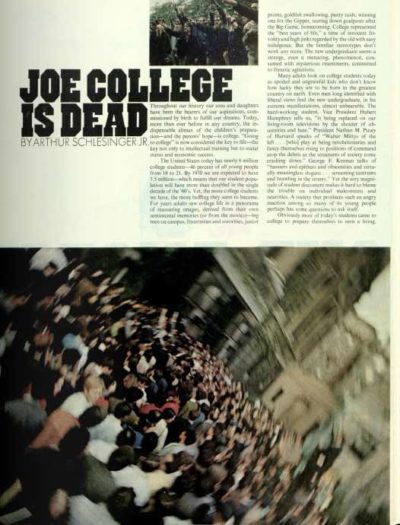
For the moment they are determined, in the words of the student orator at the Notre Dame commencement this year, not to be satisfied to “play the success game.” More college graduates every year embark on careers of public and community service. The acquisitive life of business holds less and less appeal. Yet one can hardly doubt that a good many — perhaps most — of these defiant young people will be absorbed by the System and end living worthy lives as advertising men or insurance salesmen. Hal Draper, an old radical musing on the 800 sit-inners arrested at Berkeley at the height of the Free Speech Movement, wrote, “Ten years from now, most of them will be rising in the world and in income, living in the suburbs from Terra Linda to Atherton, raising two or three babies, voting Democratic, and wondering what on earth they were doing in Sproul Hall — trying to remember, and failing.”
One must hope, for the sake of the country, that some of this fascinating generation do remember — not the angry and senseless things they may have done, but the generous hopes that prompted them to act for a better life. But who can say? Certainly not their elders. Yet the attempt at understanding may even be a useful exercise for the older generation. I discovered this in talking to students for the purposes of this piece. And I treasure a note from one who patiently cooperated. “Even as I distrust anybody of the older generation who tries to write about the younger,” the letter said, “I think it will be interesting to see how you figure it out.”
This article is featured in the July/August 2017 issue of The Saturday Evening Post. Subscribe to the magazine for more art, inspiring stories, fiction, humor, and features from our archives.
Israel’s Six-Day War: How The Post Saw It 50 Years ago

The world was stunned when Israel defeated three armies in just six days.
Until June of 1967, many people had worried that Israel would eventually be crushed by the hostile nations surrounding it.
The Jewish state had long been threatened by its neighbors Jordan and Syria. In May of 1967, president of the United Arab Republic (now Egypt) Gamal Nasser stepped up the pressure. He succeeded in getting the United Nations to remove the Emergency Force guarding Egypt’s border with Israel. Four days later he blocked all shipping in the Gulf of Aqaba heading to Israel’s southern port. Within eight days, King Hussein of Jordan signed a mutual defense pact with Egypt.
Seeing signs of an impending attack on three fronts, Israel took preemptive action on June 5. It launched air attacks that destroyed the air forces of Egypt and Syria. Without air support, both nations’ forces were left vulnerable to the Israeli army. In the following days, Israel captured the Gaza strip and all of the Sinai Peninsula to the eastern bank of the Suez Canal.

Also on June 5, Israel launched a counterattack on the Jordanian forces shelling West Jerusalem. They drove the Jordanians out of East Jerusalem and most of the West Bank.
By June 7, Israel and Jordan were ready to accept a UN-brokered cease-fire. Egypt joined the cease-fire the next day.
But Syria continued to fire on villages in northern Israel. Israel attacked the Syrians on June 9 and captured the Golan Heights after heavy fighting. Syria accepted the cease-fire on June 10.
Americans who sympathized with Israel and wanted to see the Jewish state survive were delighted with the news. And the victory pleased Americans who love a story of the underdog beating the oversized bully.
But there were some in the U.S. who weren’t quite as jubilant. Legendary correspondent Stewart Alsop accurately predicted a future mid-East stalemate, as he wrote in this 1967 editorial:
The Jam We Are In
By Stewart Alsop
July 29, 1967There is an erosion of confidence that you can almost smell, these days, in Washington’s hot, humid air. The Washington mood is a bit like that expressed in the sad little ditty unhappy children used to recite: “Nobody loves me, everybody hates me, goin’ out in the garden and eat worms. . . ,”
Our side won the Middle Eastern war, and for a few days after the brilliant Israeli victory there was a brief euphoria in official Washington. Since then, the fact has become increasingly clear that Israel’s victory was by no means necessarily a victory for the United States. For it has also become increasingly clear that there has never been a time since the last world war ended when the United States has been more nearly alone in the world.
Hardly anybody loves us, and a great many people hate us. Even the Israelis by no means love us. As several correspondents have reported from the scene, the Israelis have little admiration for this country and no sense of gratitude, and regard U.S. policy as feeble and vacillating.
The Arabs, of course, hate us. This hatred is generally dismissed in this country as mere hysteria, fanned by vicious propaganda. It is that, but it is more than that. In order to make their amazing little state viable in 1948, the Israelis forced hundreds of thousands of Arabs out of Arab cities like Jaffa and Haifa, and off the land they had tilled for centuries. Now it seems likely that the Arab refugees of 1948 will be joined in their filthy camps by tens of thousands of new refugees from Old Jerusalem and the land west of the Jordan. Is it really very surprising that the Arabs hate the Israelis? And is it any wonder that the Arabs hate the United States, as the sponsor and protector of Israel, almost more than they hate Israel itself?
In the aftermath of the six-day war, there was some hope in official Washington that the Soviets would work “in parallel” with the United States to damp down the Middle-Eastern hatreds and achieve a lasting settlement. President Johnson and Premier Kosygin did not come to blows at Holly Bush, but they came to no agreement either, and since then the hope has been dying. It seems much more probable that Soviet policy was accurately predicted by an unnamed Soviet official (probably the Russian ambassador in Paris) who was quoted as follows in the French weekly, Le Nouvel Observateur:
“The diplomatic and political battle we are going to wage at the side of the Arabs . . . will be very hard. We will blackmail the Americans with respect to their oil interests and their shipping in the Suez Canal . . . We will lead an incessant propaganda campaign among the young generations [of Arabs| against the cowards, the opportunists and the collaborators of the Anglo-Americans. . . .”
In this battle, Arab hatred will be a most useful weapon. And the stakes are high. The Israelis are brave fighters, but the Arabs outnumber them by more than 15 to 1. and they are sitting on the world’s greatest proved reserves of oil in what is historically one of the world’s greatest strategic land areas.
Moreover, in their “diplomatic and political battle” against the “Anglo-Americans,” it is now clear, the Soviets will have an enthusiastic ally in Charles de Gaulle’s France. Official Washington was hardly surprised when de Gaulle refused to join the consortium to assert the right of peaceful passage in the Gulf of Aqaba, or when he cut off the supply of arms to France’s former ally, Israel.
But there was surprise—and a good deal of rage—when it was learned that two French oil companies, with official encouragement, had attempted to move in on the Anglo-American oil interests in the oil-producing Arab countries. “If de Gaulle really does that,” said one normally unemotional American official, “we ought to break diplomatic relations with Paris.”
It has taken a long time, but the conclusion is at last being forced upon the American Government that de Gaulle really does regard the United States not only as an enemy but as the enemy. The final rupture by de Gaulle of the French-American alliance has undermined the whole American system of alliances.
NATO may be a long time a-dying. but it is dying surely, killed by de Gaulle. The German-American alliance, once rock-firm, is seriously enfeebled. The Germans, and the Japanese and the Italians as well, may join with the French in the assault on the Anglo-American oil interests
in the Middle East. The British, alone among our major allies, supported the project to assert the right of passage in the Gulf of Aqaba.
If, as a consequence of joining this country in that attempt, the British lose their oil holdings in the Arab countries, it will be a near-total economic catastrophe for them. They may be so enfeebled that they will have no choice but to crawl into the Common Market on hands and knees, on de Gaulle’s terms. De Gaulle’s basic condition, of course, is the death and public burial of the Anglo-American alliance. If that alliance dies, the United States will indeed be alone in the world, and this is one reason for the erosion of confidence you can smell in Washington’s air. The other, of course, is Vietnam.
“In a way,” one high official has remarked privately, “we were as wrong about Vietnam as about the Bay of Pigs.” He did not mean that this country was necessarily wrong to intervene in Vietnam. He did mean that the cost of intervention, in casualties, in expenditures, in military-force levels, and above all in the time required to achieve a settlement, was vastly underestimated. The awful thought that an acceptable settlement may be unachievable, and the war unwinnable, is beginning to occur, even to former official optimists.
In short, this country is in a jam all over the world. The jam we are in could be worse. It would be worse if Nasser were presiding in triumph over Tel Aviv, or Ho Chi Minh over Saigon, for example. But it is a very bad jam all the same, and we won’t get out of it by going out in the garden and eating worms. The jam we are in requires facing up to some hard questions. For example, if de Gaulle is determined to treat us as an enemy, should we not treat him likewise? What price will we pay to keep Britain out of the Common Market, and thus preserve the only alliance we have that is worth preserving? And is more of the same really all we can do in Vietnam?
The trouble is that to the people who should be asking such questions, the asking itself is a confession of failure. Many of these people are brilliantly able. But perhaps new men are needed to do the new thinking which now so clearly needs to be done.
Realizing the Dream of Citizenship
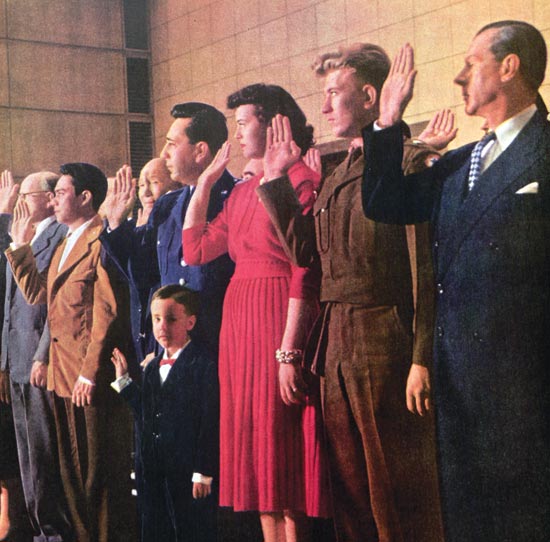
Frank Ross
This day they swear to defend the United States against all enemies. At the District Court in Washington, D.C., 141 subjects of 32 foreign nations become Americans. Wladimir the Ukrainian becomes a U.S. citizen named Walter, and Szymon the Pole plain Simon. Feige from Russia will answer to Fannie, and Liu Chia-Len to Bill. Little Dan Vega stands between Air Force Major Carl Vega and his wife, who adopted Dan in Germany and now pledge fealty to his new country on his behalf. It was a roundabout road, but Dan made it — he’s an American kid now. The strength of the United States will ensure the rights of the Constitution to each of these 141 persons. Each owes a new allegiance which he accepts “without purpose of evasion.”
The clerk of the court intones the oath, and a dream comes true.
—“Americans All”
Face of America,
June 4, 1955
This article is featured in the March/April 2017 issue of The Saturday Evening Post. Subscribe to the magazine for more art, inspiring stories, fiction, humor, and features from our archives.
A Quick Guide to Impeachment
February 24 is the anniversary of President Andrew Johnson’s impeachment in 1868. Many Americans are more familiar with Bill Clinton’s impeachment than with Johnson’s, but our un-scientific survey revealed that even well-informed people are a little fuzzy on what impeachment actually is and how it works, exactly. Here’s a quick overview:
What Is Impeachment?
Impeachment means indictment — specifically, a charge of serious misconduct against a high official by a legislature. Article II of the Constitution says the president, vice president, and “civil officers of the United States” can be impeached. Whether or not members of Congress are included in “civil officers” is still debated.
Two presidents have been impeached, but neither were convicted.
What Exactly Is an Impeachable Offense?
The Constitution defines impeachable offenses as “treason, bribery, or other high crimes and misdemeanors.” But these are broad, debatable terms.
Constitutional lawyers define “high crimes and misdemeanors” as anything that breaks existing law, is an abuse of power, or, as Alexander Hamilton wrote, is “the abuse or violation of some public trust.”
Gerald R. Ford gave a working definition of an impeachable offense: “whatever a majority of the House of Representatives considers it to be at a given moment.”
In practice, articles of impeachment have cited acts that exceed the constitutional limits of the powers of an office, behavior at odds with the function and purpose of an office, or use of an office for improper purposes or personal gain.
How Does the Impeachment Process Work?
The House Indicts
The House of Representatives begins the impeachment process. The House Judiciary Committee starts the process by sending to the House articles of impeachment, a resolution that spells out why impeachment is justified. The House then debates and votes on that resolution. An official is impeached only if two-thirds of the House approves the articles of impeachment. But the House can’t take action beyond this vote, and the impeached official isn’t removed from office.
The Senate Convicts and Expels
The impeached official now faces a trial in the Senate. The Chief Justice of the Supreme Court acts as judge in the proceedings, and the Senators are the jury. After hearing the evidence, the Senators meet privately and discuss their verdict. If two-thirds of the Senators agree, the impeached official will be convicted and removed from office. The Senate may even pass a resolution forbidding the official from ever again holding public office.
Who Has Been Impeached?
- Moves toward impeachment were made against John Tyler (1841-1845) when Congress resented his use of the presidential veto, but the resolution against him failed.
- Andrew Johnson (1865-1869) was impeached for his lenient attitude toward the defeated Confederate states, which allowed many of its pre-war officials to return to office. The triggering event was his dismissal of Edwin Stanton, Lincoln’s Secretary of War, who opposed Johnson’s policies. Johnson was impeached by the House, tried in the Senate, and acquitted by a single vote.
- Congress was debating the impeachment of Richard Nixon (1969-1974) over the Watergate scandal when he resigned.
- Bill Clinton (1993-2001) was charged in 1998 with perjury and obstruction of justice in the investigation of his affair with a White House intern. He was impeached by the House but acquitted by the Senate.
Extra Credit: The First Impeachment Hearings
Americans are naturally troubled by the prospect of a presidential impeachment. In March 1868, when President Andrew Johnson was being impeached, the Post reassured readers that impeachment was a necessary, vital part of our democratic process. It contrasted, perhaps unfairly, the orderly process of trying the U.S. president to the armed turmoil shaking the governments of Mexico and Santo Domingo (now the Dominican Republic). But it expressed ultimate faith in the American people and their Constitution.
Not Mexico
For a short period dining the first excitement of the Impeachment, we began to doubt whether we were living in the United States or in Mexico — but the sober second thought of the people soon rectified the blunders of foolish partisans.
The House of Representatives has an undoubted right to impeach the President, or the Acting President, whichever his true position may be. Its members have the right to judge for themselves of the propriety of their course.
The Senate has the undoubted right — nay more it is its duty — to sit in judgment on the charges that are brought by the House — and acquit, or find guilty, as a majority of two-thirds sees proper. If the Senate finds President Johnson guilty of high crimes and misdemeanors, he must, and doubtless will, without any hesitation, conform to that judgment.
It may be said, that both House and Senate may act in the spirit of mere partisans, and alike accuse and condemn without sufficient evidence. Undoubtedly they may. But the Constitution supposes that they will not. If they do act as mere partisans, their punishment will be the rebuke of the people.
In the Autumn, the Republican party goes before the People — with its candidate for the Presidency, its candidates for Congress. The fair or unfair manner in which the Impeachment trial has been conducted, will be an important element in the canvass. In fact, the Impeachers themselves will be then put on their trial, before the great Jury of the People of the United States.
And thus there is no need of soldiers and bayonets — no need to make these United States a Mexico or St. Domingo. Ultimately all these vexed questions must be decided by the people. Ultimately the will of the people will prevail. Both the contending parties profess to desire this. Let all then be done peaceably, legally, and in order. It will be no recommendation to either party, in the great Presidential and Congressional campaign of the coming Autumn, that it has needlessly broken the peace, and plunged the Union into civil strife.
Editorial, March 7, 1868
Featured image: Impeachment ticket for President Johnson (U.S. Senate)
Conflicts of Interest: The Post’s Solution
Conflict of interest has been a frequent topic in the news, as people debate the ethics of President Donald Trump’s foreign and domestic business dealings.
The principle of “conflict of interest” is clear: It’s the difference between personal interests and official responsibilities. Conflict-of-interest laws have been established, as Justice Antonin Scalia put it, to ensure each lawmaker will use his influence and his vote “as trustee for his constituents, not as a prerogative of personal power.”
What is less clear, though, is how to know when a politician has chosen personal gain over public good. How can you judge a senator’s personal intentions when he or she votes?
The problem of divided loyalties reaches back to the early years of our republic. Thomas Jefferson knew the money of special interests would tempt lawmakers. When he presided over the Senate in 1801, he established a rule that said, “Where the private interests of a member are concerned in a bill or question, he is to withdraw.”
Whenever a congressman did not recuse himself from matters touching on his personal interests, the law continued, his arguments and his vote should be tossed out.
It would be hard to say how faithfully Congress followed Jefferson’s law. But we know that, just seven years after Jefferson’s death, Senator Daniel Webster was selling his services to the Bank of the United States. Webster was on the committee that was considering the bank’s charter at a time when President Andrew Jackson wanted to shut it down. Webster strongly supported the bank, but not for free, it appears. In 1833, Webster wrote the bank president, “I believe my retainer has not been renewed or refreshed as usual. If it be wished that my relation to the bank should be continued, it may be well to send me the usual retainers.”
By 1874, the House of Representatives had fallen even further from Jefferson’s strict adherence. In that year, it passed a law that allowed congressmen to vote in their private interests so long as the measure benefitted others — presumably their constituents. The law was promoted by Speaker of the House James Blaine. At the time, Blaine was offering his services to the Little Rock and Fort Smith Railroad in exchange for stock.
By 1962, corruption scandals prompted Congress to pass Title 18, Second 208 of the U.S. Code. This law barred legislators from participating in matters in which they, their families, their business partners, or their associations could financially benefit.
When the legislators wrote the law, they made it apply to all public officials in the federal government except the president and vice president.
The law hasn’t resolved all the questions about conflicted interests. Enforcing the law requires investigators to prove that a legislator intended to benefit himself, and it’s hard to prove intentions.
While the Post editors welcomed the 1962 law, they expected further problems with congressional corruption. So they offered a simple solution, one which would resolve questions of who benefited from what: disclosing personal finances.
Disclosure: An Antidote for Conflict of Interests
Last fall Post editors Ben Bagdikian and Don Oberdorfer explored in depth the problem of conflict of interests in the Congress of the United States. They reported that while the Congress forbade government officials and judges to hold private financial stakes which might conflict with their public duties, there was nothing to prevent members of the legislative body from doing that very same thing themselves. Bagdikian and Oberdorfer concluded that “one possible solution to the problem of hidden interests is for every member of Congress, or every candidate for Congress, to reveal his finances to his fellows and the public.”
Several members of Congress had already taken this step. Sen. Joseph Clark revealed his wealth last fall, and his fellow Pennsylvanian, Sen. Hugh Scott, followed suit. Sen. Stephen Young of Ohio sold his stock in two sugar companies and an airline when committee assignments gave him special powers in these fields. He also disclosed his stock holdings.
Recently Sen. Jacob Javits of New York revealed his stock holdings on the floor of the Senate. His colleague, Sen. Kenneth Keating, announced his intention to publish a list of his securities holdings and introduced a bill to require such disclosure by members of the House and Senate. Congresswoman Edith Green of Oregon has proposed establishment of a 15-member commission on legislative ethics to study the conflict-of-interests question. She has introduced bills that would require, among other things, a full disclosure by congressmen of their financial interests.
Congress should pass such legislation. It would accomplish two important objectives: First, it would eliminate the double standard that now prevails by putting Congress on the same ethical footing with the executive branch of the Government; second, disclosure would be the most effective means of preventing members of Congress from taking advantage of the public trust that their public offices imply.
Editorial, April 6, 1963
Unfortunately, disclosing finances doesn’t end all questions of conflicts of interest. Last September, Donald Trump filed a 104-page financial disclosure, but he didn’t share his tax returns. For critics, many concerns remain.
Featured image: Shutterstock